The Cardinals of the Holy Roman Church (original) (raw)
The Cardinals of the Holy Roman Church Biographical Dictionary Pope Pius XII (1939-1958) Consistory of February 18, 1946 (I)
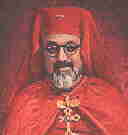
(1) 1. AGAGIANIAN, Grégoire-Pierre XV
(1895-1971)
Birth. September 18, 1895, Akhaltzikhe, Armenian ordinariate of Caucasus, Russia. His baptismal name was Gazaros (the Armenian equivalent of Lazarus, or Lazare in French). He was known as Gazaros Agagianian until he was elected patriarch of Cilicia of the Armenians. He is also listed as Krikor Bedros XV Aghadjanian. He lost his father, Harutiun, at an early age; his mother's name was Iskuhi Sarukhanyan. As his homeland came to be under Soviet rule, he did not see some members of his family after he left for Rome in 1921 until 1962, when, at the personal intervention of Soviet leader Nikita Khrushchev, his sister Elisaveta was allowed to travel to see him in Rome.
Education. Studied at the Seminary of Tiflis (now Tbilisi), Georgia, Russia; and at the Pontifical Urbanian Athenaeum "De Propaganda Fide," Rome.
Priesthood. Ordained, December 23, 1917, Rome. Pastoral ministry, Tiflis, 1918-1921. Faculty member and vice-rector of the Pontifical Armenian College, Rome, 1921-1932; faculty member of the Pontifical Urbanian Athenaeum "De Propaganda Fide," Rome, 1922-1932; rector of the Pontifical Armenian College, Rome, 1932-1937. Privy chamberlain of His Holiness, August 5, 1932. Apostolic Visitor to the Patriarchal Institute of Bzommar, Beirut, Lebanon, 1935.
Episcopate. Elected titular bishop of Comana di Armenia, July 11, 1935. Consecrated, July 21, 1935, church of S. Nicola Tolentino, Rome, by Serge Der Abrahamian, titular bishop of Cucuso, ordinating prelate for the Armenian rite in Rome, assisted by Bartolomeo Cattaneo, titular archbishop of Palmira, general treasurer of the Apostolic Chamber, and by Pietro Pisani, titular archbishop of Tomi, delegate of the Oriental Church in Rome. His episcopal motto was Iustitia et Pax. Elected patriarch of Cilicia by the Armenian Synod, November 30, 1937; received papal confirmation, December 13, 1937. He took the name Grégoire-Pierre XV, or Krikhor-Bedros XV in Armenian.
Cardinalate. Created cardinal priest in the consistory of February 18, 1946; received the red hat and the title of S. Bartolomeo all'Isola, February 22, 1946. President of the Pontifical Commission for the Revision of the Code of Oriental Canon Law, July 2, 1955. Pro-prefect of the S.C. for the Propagation of the Faith, June 18, 1958 until July 18, 1960; prefect, July 18, 1960 until October 19, 1970. Participated in the conclave of 1958, which elected Pope John XXIII. Papal legate to the Marian Congress, Saigon, South Vietnam, January 31, 1959. Papal legate to the Patrician Congress, Dublin, Ireland, June 15 to 23, 1961, to commemorate the 1500th Anniversary of the death of St. Patrick, patron saint of Ireland. Resigned patriarchate, August 25, 1962. Attended the Second Vatican Council, 1962-1965; member of the Board of Presidency, 1963-1965. Participated in the conclave of 1963, which elected Pope Paul VI. Papal legate to the 38th International Eucharistic Congress, Bombay, India, November 11, 1964. Participated in the First Ordinary Assembly of the Synod of Bishops, Vatican City, September 29 to October 29, 1967; the First Extraordinary Assembly of the Synod of Bishops, Vatican City, October 11 to 28, 1969. Camerlengo of the Sacred College of Cardinals, April 28, 1969 until May 18, 1970. Cardinal bishop of the title of the suburbicarian see of Albano, October 22, 1970. By the time of his death, he had lost completely his eyesight to his debilitating illness.
Death. May 16, 1971, of cancer, in Rome; Pope Paul VI had visited him a few weeks before his death. Buried in the Armenian church of S. Nicola da Tolentino, Rome.
Beatification. On February 4, 2020, Cardinal Angelo De Donatis, vicar general of Rome, issued a decree concerning the beginning of the process for his beatification. On October 28, 2022, the ceremony, which marks the beginning of the cause of beatification took place at noon in the papal Lateran basilica, Rome, in the presence of the current Armenian patriarch Raphaël Bedros XXI Minassian and Cardinal De Donatis, representing the diocese in which the servant of God died and is buried.
Bibliography. Croaty, A. Cardinal Agagianian, papal legate: a profile. Dublin: J. Duffy, 1961.
Webgraphy. His photograph and arms, Araldica Vaticana; photographs and biography, in English, Wikipedia;Gallery of the Armenian Catholic Patriarchs, HaYaSeR 2002; Cardinal Agagianian Is Dead; Scholarly Mission Leader, 75, The New York Times, Reuters, Rome, May 17, 1971; The Armenian Cardinal and His Servant by Tom Vartabedian, The Armenian Weekly, February 6, 2012; Causa de beatificação e canonização do patriarca da Igreja Católica Armênia, Vatican News, 22 abril 2020, 07:21; 50 anni fa moriva il Cardinale Aghagianian by Marco Mancini, ACI Stampa, Città del Vaticano, 16 maggio, 2021 / 2:00 PM; Europe/Italy - The Armenian Catholic Bishops committed to beginning the process of canonization of Cardinal Agagianian, Prefect of Propaganda Fide from 1960 to 1970, Agenzia Fides, Rome, Monday, 14 February 2022; Bispos armênios querem abrir o Processo de canonização do cardeal Agagianian, Vatican News, 21 fevreiro 2022, 15:22, with audio; Asia/Lebanon - The canonization process of Armenian Cardinal Agagianian opens on October 28th, Agenzia Fides, Bzommar, Monday, 29 August 2022; Em 28 de outubro, início do Processo de canonização do cardeal armênio Agagianian, Vatican News, 29 agosto 2022, 15:31, with audio; Em S. João de Latrão, abertura da causa de beatificação do cardeal Agagianian, Vatican News, 12 outubro 2022, 15:56, with audio; Il profilo. Verso gli altari Agagianian, il cardinale armenoby Filippo Rizzi, Avvenire, venerdì 28 ottobre 2022; Aperta la fase diocesana della causa di beatificazione e canonizzazione di Gregorio Pietro XV Agagianian by Roberta Punpo, Servizio Informazione Religiosa, 28 Ottobre 2022; Aperta la fase diocesana della causa di beatificazione del Cardinale Agagianian by Marco Mancini, ACI Stampa, Roma, 28 ottobre, 2022 / 4:00 PM; Beatification process begins for Patriarch Agagianian who helped Armenians rise after the genocide, AsiaNews.it, 10/28/2022, 20.08.
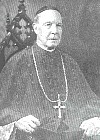
(2) 2. GLENNON, John Joseph
(1862-1946)
Birth. June 14, 1862, Kinnegad, diocese of Meath, Ireland. Son of Matthew Glennon,a farmer, and Catherine Rafferty. Although he was born in Ireland, the previous residence of his father in New Jersey, United States of America, brought him U.S. citizenship at birth. He was the eldest of twelve children.
Education. Studied at St. Mary's College, Mullingar; at All Hallows College and Seminary, Dublin; and at the University of Bonn, Germany. After finishing his studies, he went to the United States of America.
Priesthood. Ordained, December 20, 1884, Kansas City cathedral, by John Joseph Hogan, bishop of Kansas City. Pastoral ministry in diocese of Kansas City, 1884-1896. Rector of the cathedral; Vicar general of Kansas City, 1892-1894. Apostolic administrator of Kansas City, 1894-1896.
Episcopate. Elected titular bishop of Pinora and appointed coadjutor of Kansas City, with right of succession, March 14, 1896, Consecrated, June 29, 1896, Kansas City, by John Joseph Kain, archbishop of St. Louis, assisted by Maurice Burke, bishop of St. Joseph, and by John Joseph Henessy, bishop of Wichita. His episcopal motto was Crux fidelis lux perennis. Appointed coadjutor bishop, with right of succession, and apostolic administrator of St. Louis, April 27, 1903. Succeeded to the metropolitan see of St. Louis, October 13, 1903. During his tenure in St. Louis, he established 93 new parishes, built the present Byzantine cathedral which back then amounted to $3,800,000 and ordained some 4,700 young men to the priesthood. Assistant at Pontifical Throne, June 28, 1921. On Christmas Eve 1945, it was announced that Archbishop Glennon would be elevated to the Sacred College of Cardinals. He originally thought himself to be too old to make the journey to Rome, but eventually joined fellow Cardinals-elect Francis Joseph Spellman and Thomas Tien Ken-sin, S.V.D., on their flight, during which time Archbishop Glennon caught a cold from which he would not be able to recover.
Cardinalate. Created cardinal priest in the consistory of February 18, 1946; received the red hat and the title of S. Clemente, February 22, 1946. During the return trip to the United States, the cardinal stopped in his native Ireland, where he was received by President Seán T. O'Kelly and Taoiseach Éamon de Valera. While in Dublin, he was diagnosed with uremic poisoning and later died.
Death. March 9, 1946, at 8:51 a.m., in the Dublin home of the president of Ireland. His body was returned to St. Louis and buried in the crypt of the metropolitan cathedral of that city (1). The only diocesan hospital for children in the United States, "Cardinal Glennon Children's Hospital", affiliated with St. Louis University Medical Center, was established in his name.
Bibliography. Bransom, Charles N. Ordinations of U. S. Catholic bishops 1970-1989. A chronological list. Washington, D.C. : National Conference of Catholic Bishops ; United States Catholic Conference, 1990, p. 51; Code, Bernard. Dictionary of the American Hierarchy (1789-1964). New York : Joseph F. Wagner, 1964, p. 112; Finn, Brendan A. Twenty-four American cardinals. Boston: B. Humphries, 1947; Schneider, Nicholas A. The life of John Cardinal Glennon, Archbishop of St. Louis. Liguori, Mo. : Liguori Publications, 1971; Thornton, Francis B. Our American princes. New York: Putnam, 1963.
Webgraphy. Archbishop John Joseph Cardinal Glennon Papers, 1834-1984, Archdiocese of Saint Louis Archives and Records; photographs and biography, researched and written by Ashley Corbin, Morgan Evitts, Sien Gallop, Sarah Gilfillan, Somer Hill, Dylan Robb, and Jason Welch, archcityreligion.org; biography, in English, Encyclopedia.com; his arms and photograph, Araldica Vaticana; 75 anni fa moriva il Cardinale Glennon by Marco Mancini, ACI Stampa, St. Louis, 09 marzo, 2021 / 9:00 AM.
(1) This is the inscription in his vault, kindly provided by Mr. Eman Bonnici, from Malta:
CARDINAL JOHN J. GLENNON 1862 - 1946

(3) 3. ALOISI MASELLA, Benedetto
(1879-1970)
Birth. June 29, 1879, Pontecorvo, Italy. From a noble family of Neapolitan origin. Son of Count Pietro Aloisi Masella and Registilla Deci. Nephew of Cardinal Gaetano Aloisi Masella (1887).
Education. Studied at the Seminary of Ferentino; while in Rome, he resided at Almo Collegio Capranica; then, he studied at the Pontifical Gregorian University, Rome; later, at the Pontifical Roman Athenaeum "S. Apollinare"; and finally at the Pontifical Ecclesiastical Academy, Rome, where he studied diplomacy.
Priesthood. Ordained, June 1, 1902, Rome. Secretary to his uncle Cardinal Gaetano Aloisi Masella. Staff member, Secretariat of State, 1906-1908. Secretary of the nunciature in Portugal, 1908-1910; chargé d'affaires of the nunciature in Portugal, 1910-1919. Privy chamberlain of His Holiness, December 25, 1914. Domestic prelate of His Holiness, September 29, 1917. Nuncio to Chile, November 20, 1919.
Episcopate. Elected titular archbishop of Cesarean di Mauritania, December 15, 1919. Consecrated, December 21, 1919, chapel of the Pontifical Collegio Pio Latino Americano, Rome, by Cardinal Pietro Gasparri, secretary of State, assisted by Sebastião Leite de Vasconcellos, titular archbishop of Damiata, and by Antonio Maria Iannotta, bishop of Sora, Aquino e Pontecorvo. Papal legate to the Coronation of Our Lady of Monte Carmelo, Santiago, Chile, November 29, 1926. Named nuncio to Brazil, April 26, 1927.
Cardinalate. Created cardinal priest in the consistory of February 18, 1946; received the red hat and the title of S. Maria in Vallicella, February 22, 1946. Papal legate to the Coronation of Our Lady of Fatima, Portugal, April 28, 1946. Opted for the order of cardinal bishops and the suburbicarian see of Palestrina, June 21, 1948. Archpriest of the patriarchal Lateran basilica, Rome, October 27, 1954. Prefect of the S.C. for the Discipline of the Sacraments, October 27, 1954. Papal legate to the 36th International Eucharistic Congress, Rio de Janeiro, Brazil, June 21, 1955. Camerlengo of the Holy Roman Church, October 9, 1958. Participated in the conclave of 1958, which elected Pope John XXIII. Camerlengo of the Sacred College of Cardinals, March 19, 1962 until September 26, 1964. Attended the Second Vatican Council, 1962-1965. Participated in the conclave of 1963, which elected Pope Paul VI. Cardinal bishop of title of suburbicarian see of Palestrina, November 17, 1966 (1). Camerlengo of the Sacred College of Cardinals, March 19, 1967 until 1968. Participated in the First Ordinary Assembly of the Synod of Bishops, Vatican City, September 29 to October 29, 1967. Resigned prefecture of the S.C. for the Discipline of the Sacraments, January 11, 1968, and became prefect emeritus. Participated in the Extraordinary Assembly of the Synod of Bishops, Vatican City, October 11 to 28, 1969.
Death. September 30, 1970, at 11:30 a.m., from kidney disease, Rome. Buried in the cathedral of Pontecorvo (2). At his death, he was the oldest member of the Sacred College of Cardinals. There is a street in Torrevecchia, Rome, named after him and there is another one in Pontecorvo also named after him.
Webgraphy. His arms and biography, in Italian, Wikipedia; portrait, photographs and biography by Eman Bonnici, Find a Grave; photographs, portarit and arms, Araldica Vaticana; his arms on a medal during the Vacant See of 1958, Black Mountain Coins; Il nostro animo, lettera del Papa Paolo VI al Cardinal Benedetto Aloisi Masella in occasione della deposizione della carica di Prefetto della Congregazione per il Culto Divino e la Disciplina dei Sacramenti, in Italian, Libreria Editrice Vaticana, 11 gennaio 1968; Lettera del Papa Paolo VI al Cardinal Benedetto Aloisi Masella in occasione del 90º genetliaco, in Italian, Libreria Editrice Vaticana, 24 giugno 1969.
(1) The motu proprio Suburbicariis sedibus, issued by Pope John XXIII on April 11, 1962, established that the cardinal bishops would have no ordinary jurisdiction over their suburbicarian sees. These dioceses were to be ruled by bishops with complete and independent ordinary power; cardinal bishops would only retain the title of the see. The disposition applied only to the cardinal bishops appointed in 1961 and later. The others, Cardinals Eugène Tisserant, Clemente Micara, Benedetto Aloisi Masella and Giuseppe Pizzardo, retained the denomination of bishops of their sees. On November 17, 1966, they were listed as bishops of the title of their suburbicarian sees in Annuario Pontificio per l'anno 1967, except Cardinal Micara, who had died in 1965.
(2) This is the text of the inscription on his funeral monument, kindly ptovided by Mr. Eman Bonnici, from Malta:
IL CARDINALE BENEDETTO ALOISI MASELLA CAMERLENGO DI SANTA ROMANA CHIESA ARCIPRETE DELL’ARCIBASILICA LATERANENSE NATO A PONTECORVO IL 29 GIUGNO 1879 MORTO A ROMA IL 30 SETTEMBRE 1970 SCELSE NELLA TERRA NATALE QUESTO SACRO LUOGO PER L’ATTESA DELLA RISURREZIONE DI CRISTO ONORÒ LA NOBILITÀ DEL NOME CON SPLENDORE DI VIRTÙ E LUNGO FECONDISSIMO EPISCOPATO NELLE NUNZIATURE DEL CILE E DEL BRASILE NELLA DIOCESI SUBURBICARIA DI PALESTRINA IN CURIA DOVE RIFULSE PER SAGGEZZA DI CONSIGLIO BONTÀ DI ANIMO PROFONDA PIETÀ IMPAREGGIABILE AMORE ALLA CHIESA

(4) 4. MICARA, Clemente
(1879-1965)
Birth. December 24, 1879, Frascati, Italy. From a well-to-do family. Grand-nephew of Cardinal Ludovico Micara, O.F.M.Cap. (1824).
Education. Studied at the Pontifical Roman Seminary, Rome, while residing at Almo Collegio Capranica; then, at the Pontifical Gregorian University, Rome; later, at the Pontifical Lateran Athenaeum, Rome; and finally, at the Pontifical Ecclesiastical Academy, Rome, where he studied diplomacy.
Priesthood. Ordained, September 20, 1902, Rome. Further studies, 1902-1904. Staff member of the Secretariat of State, 1904-1909. Secretary of the nunciature in Argentina, 1909-1915. Privy chamberlain of His Holiness, January 5, 1910; reappointed, December 25, 1914. Auditor of the nunciature in Belgium, April 16, 1915; in the nunciature in Austria, 1916-1919. Domestic prelate of His Holiness, August 21, 1918. Special papal envoy to Czechoslovakia, 1919-1920.
Episcopate. Elected titular archbishop of Apamea di Siria, May 7, 1920. Named nuncio in Czechoslovakia, May 17, 1920. Consecrated, August 8, 1920, chapel of the Bohemian College, Rome, by Cardinal Pietro Gasparri, secretary of State, assisted by Antonio Valbonesi, titular bishop of Memfi, and by Karl Kašpar, titular bishop of Betsaida, auxiliary of Hradec-Králové. His episcopal motto was In Domino confido. Nuncio in Belgium and internuncio in Luxemburg, May 30, 1923. Extraordinary papal envoy to consign the Golden Rose to Queen Elizabeth of Belgium, December 10, 1925. A talented violoncello player, he used to participate in musical events organized by Queen Elizabeth of Belgium at her royal castle. Resided in Rome during Belgium's occupation by the Nazi regime, 1940-1944. Resumed his nunciature in Belgium, 1944-1946.
Cardinalate. Created cardinal priest in the consistory of February 18, 1946; received the red hat and the title of S. Maria sopra Minerva, February 22, 1946. Opted for the order of cardinal bishops and the suburbicarian see of Velletri, retaining in commendam ad nutum Summi Pontificis his title, June 13, 1946 (1). Prefect of the S.C. of Rites, October 28, 1947 to November 11, 1950. Papal legate to the 7th centennial celebration of Cologne's cathedral, July 25, 1948; to the Bolivarian Eucharistic Congress, Cali, Colombia, January 6, 1949. Prefect of the S.C. of Religious, November 11, 1950 to January 1951. Pro-prefect of the S.C. of Rites, November 11, 1950 to January 26, 1953. Vice-dean of the Sacred College of Cardinals, January 13, 1951. Vicar general of Rome and its district, January 26, 1951. Papal legate to the 10th National Eucharistic Congress, Namur, Belgium, June 2, 1951; to the 15th National Eucharistic Congress, Nîmes, France, September 15, 1951. He was president of the Pontifical Commission of Sacred Archeology from 1951 until his death. Participated in the conclave of 1958, which elected Pope John XXIII. Camerlengo of the Sacred College of Cardinals, March 28, 1960 until January 16, 1961. Attended the first three sessions of the Second Vatican Council, 1962-1964. Participated in the conclave of 1963, which elected Pope Paul VI. During his tenure as vicar general of Rome, he founded over one hundred new parishes and took care of the construction of several others.
Death. March 11, 1965, in the evening, after a long illness, Palazzo della Cancelleria, Rome. Buried in the basilica of S. Maria sopra Minerva, Rome (2).
Webgraphy. His arms and biography, in Italian, Wikipedia; his arms and biography, in French, Wikipedia; photographs, portraits and arms, Araldica Vaticana.
(1) The motu proprio Suburbicariis sedibus, issued by Pope John XXIII on April 11, 1962, established that the cardinal bishops would have no ordinary jurisdiction over their suburbicarian sees. These dioceses were to be ruled by bishops with complete and independent ordinary power; cardinal bishops would only retain the title of the see. The disposition applied only to the cardinal bishops appointed in 1961 and later. The others, Cardinals Eugène Tisserant, Clemente Micara, Benedetto Aloisi Masella and Giuseppe Pizzardo, retained the denomination of bishops of their sees. On November 17, 1966, they were listed as bishops of the title of their suburbicarian sees in Annuario Pontificio per l'anno 1967, except Cardinal Micara, who had died in 1965.
(2) This is the inscription on his funeral monument, kindly provided by Mr. Eman Bonnici, from Malta:
HIC · SITVS · TRANQVILLA · PACE · COMPOSITVS · IN · CHRISTO ·QVIESCIT CLEMENS · S·܁ R · E ܁· CARD·܁ MICARA VELITERNUS · EPISCOPVS · IN · VRBE · VICE · SACRA · ANTISTES · HVIVS · BASILI COMMENDATARIVS · TVSCULI · IX · KAL · IAN · MDCCCLXXX · NATVS SANCTISSIME · DECESSIT · ROMAE · V · IDUS · MARTII · AN · DOM ·MCMLXV
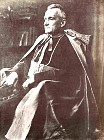
(5) 5. SAPIEHA, Adam Stefan
(1867-1951)
Birth. May 14, 1867, castle of Krasiczyn, diocese of Przemysl, Poland, of a noble family. Youngest of the seven children of Adam Stanisław Count Sapieha-Kodeński and Princess Jadwiga Klementyna Sanguszko-Lubartowicz. He had four brothers, Władysław Leon, Leon Paweł, Paweł Jan, and Jan Piotr; and two sisters: Maria Jadwiga and Helena Maria. Baptized, May 19, 1867, by Father Antoni Kozański. His baptismal name was Adam Stefan Stanisław Bonfatiusz Józef. His last name is also listed as Sapieha-Kodeński. Relative of Cardinal Włodzimierz Czacki(1882). Related to Aleksander Sapieha, bishop of Vilnius (1667-1671); to Paweł Sapieha, bishop of Samogitia (1715); and to Józef Sapieha, bishop coadjutor of Vilnius.
Education. He studied at the Wyższe Gimnasium, Lwow, 1886; at Jagielloński University, Kraków; and at the Pontifical Gregorian University, Rome, where he obtained a doctorate on July 10, 1896. Received the subdiaconate on May 27, 1893; and the diaconate on July 15, 1893.
Priesthood. Ordained, October 1, 1893, Rome by Jan Puzyna de Kosielsko, titular bishop of Memphis, auxiliary of Leopolis of the Latins. Pastoral ministry in diocese of Lemberg; professor at Wyższe gimnasium, Lwow, 1886; faculty member of its seminary, 1893-1897; vice-rector, September 23, 1897 to October 27, 1910. Canon of the cathedral chapter of Lemberg, 1902. Privy chamberlain participantium, February 23, 1906.
Episcopate. Elected bishop of Kraków, November 27, 1911. Consecrated, December 17, 1911, Sistine Chapel, Vatican apostolic palace, by Pope Pius X, assisted by Augusto Silj, titular archbishop of Cesarea di Capadocia, secret almoner of His Holiness, and by Agostino Zampini, O.S.A., titular bishop of Porfireone, papal sacristan. His episcopal motto was Crux Mihi Foederis Arcus. He celebrated a diocesan synod in 1923. Promoted to archbishop when Kraków was elevated to metropolitan see, October 28, 1925.
Cardinalate. Created cardinal priest in the consistory of February 18, 1946; received the red hat and the title of S. Maria Nuova e S. Francesca Romana, February 22, 1946.
Death. July 23, 1951, at 7:15 a.m., archbishop's palace, Kraków. Buried on July 28 in Wawel cathedral, Kraków, near the altar of the confession of Sw. Stanisław (1).
Bibliography.
-Bogacz, Roman. Ksiaze niezlomny : kardynal Adam Stefan Sapieha. Kraków : Wydawn. UNUM, 2001;
-Boron, Piotr ; Kosior, Boleslaw ; Laszczak, Kazimierz. Adam Stefan ksiaze Sapieha 1867-1951 - kardynal, metropolita krakowski. Kraków : Komitet Obywatelski miasta Krakowa, 2001;
-Czajowski, Jacek. Kardynal Adam Stefan Sapieha. Wroclaw : Ossolineum, 1997;
-Dutka, Joanna ; Zakrzewski, Maciej ; Szarek, Jarosław. Człowiek, duszpasterz, mąż stanu : kardynał Adam Stefan Sapieha. Kraków : Instytut Pamięci Narodowej - Komisja Ścigania Zbrodni przeciwko Narodowi Polskiemu, 2011;
-Dwadzieścia pięć lat pasterzowania księcia metropolity Adama Stefana Sapiehy : jubileuszowa księga pamiątkowa 1912/1937. Edited by Ferdynand Machay. Kraków : Komitet Jubileuszowy, 1937;
-Machay, Ferdynand. Dwadziescia piec lat pasterzowania Ksiecia Metropolity Adama Stefana Sapiehy. Kraków : nakl. Komitetu Jubileuszowego, 1937. Other titles: 25 lat pasterzowania Ksiecia Metropolity Adama Stefana Sapiehy : 1912-1937; Jubileuszowa Ksiega Pamiatkowa 1912-1937;
-Nitecki, Piotr. Biskupi Kościoła w Polsce w latach 965-1999. Słownik biograficzny. Przedmowa Henryk Gulbinowicz. Warszawa : Instytut Wydawniczy "Pax", Warszawa 2000, col. 392-393;
-Nowak, Jan. "Książę kardynał Adam Stefan Sapieha jako apostoł miłosierdzia w naszej ojczyźnie", in Polonia Sacra, 18 (2014) nr 2 (35), 177-193;
-Ośko, Jan. Ksiąźę. Rzecz o kardynale Adamie Stefanie Sapieże. Ząbki: Apostolicum Wydawnictwo Księży Pallotynów Prowincji Chrystusa Króla: 2009;
-Pawlikowski, Tomasz. Adam Stefan Kardynal Sapieha. Lublin : Wydawn. "Test", 2004. (Ludzie niezwykli; Biblioteka im. sw. Jadwigi Królowe);
-Pease, Neal. Rome's most faithful daughter : the Catholic Church and independent Poland, 1914-1939. Athens : Ohio University Press, 2010. (Ohio University Press Polish and Polish-American studies series); -Prokop, Krzysztof Rafał. Polscy kardynałowie. Kraków : Wydawnictwo WAM, 2001, pp. 251-264;
-Przybyszewski, Bolesław. Adam Syefan Kardynal Sapieha : pasterz dobry, ksiaze niezlomny, 1867-1951. Lancut : Wydawn. De arte, 2002;
-Rożek, Michał. Kardynał Sapieha. Kraków : Wydawnictwo WAM 2007;
-Sapieha, Adam Stefan. O Akcji katolickiej. Kraków : [s.n.], 1930;
-Sapieha, Adam Stefan. Jaśnie Oświecony i Najdostojniejszy Książę Biskup Krakowski dr. Adam Sapieha. Kraków : [s.n.], 1916;
-Sapieha, Adam Stefan. O wychowaniu : list pasterski Księcia Metropolity Krakowskiego. Kraków : [s.n.], 1930;
-Stepień, Stanisław. Kardynał Adam Stefan Sapieha Środowisko Rodzinne, Życie i Dzieło. Przymyśl : Poludniowo-Wschodni Instytut Nauk. w Przymyślu, 1995;
-Święch-Płonka, Małgorzata. Kardynał Adam Stefan Sapieha 1867-1951 : książę niezłomny. Kraków: Polska Akademia Umiejętności, 2014;
-Urban, Jacek. Pierwsze lata poslugi ksiecia-biskupa Adama Stefana Sapiehy w diecezji krakowskiej. Kraków : Wydaw. Naukowe Papieskiej Akademii Teologicznej, 2003;
-Wielopolska, Maria Jehanne. Biskup Sapieha w zupelnej zgodzie z prawem i co z tego za wniosek. [s. l.] : nakl. aut., Druk. Rotacyjna, 1937;
-Wolny, Jerzy ; Zawadzki, Roman Maria. Archidiecezja Krakowska za pasterzowania Adama Stefana Sapiehy : praca zbiorowa. Kraków : Polskie Towarzystwo Teologiczne, 1982. (Ksiega Sapiezynska; t. 1); Corporate name: Ecclesia Catholica. Archidiecezja Krakowska;
-Wolny, Jerzy ; Zawadzki, Roman Maria. Ksiega Sapiezynska : praca zbiorowa. 2 vols. Kraków : Polskie Tow. Teologiczne, 1982. Contents: t. 1. Archidiecezja krakowska za pasterzowania Adama Stefana Sapiehy -- t. 2. Dzialalnosc koscielna i narodowa Adama Stefana Sapiehy;
-Wróbel, Wieslaw. Troska biskupa Adama Sapiehy o wysiedlonych i uchodzców w latach 1914-1916. Kraków : Wydaw. Sw. Stanislawa BM Archidiecezji Krakowskiej, 1999.
Webgraphy. Photographs, arms and biography, in Polish, Wikipedia; photograph and biography, in Polish, encyklopedia.pwn.pl; his genealogy, in Polish, genealogia.grocholski.pl; his coat of arms, relief in courtyard of archbishop residence, Kraków, Wikimedia; Śmierć i pogrzeb kardynała Adama Stefana Sapiehy (The death and funeral of Cardinal Adam Stefan Sapieha), in Polish, naszczas.pl; arms, photographs and portrait, Araldica Vaticana;his statue at the entrance to the Church of St. Francis of Assisi in Kraków, Waymarking.com; List of bishops and archbishops of Kraków, readtiger.com; Review of "Kardynał Adam Stefan Sapieha" by Jacek Czajowski; Reviewed by Dagmara M. Jaźwa, Adam A. Hetnal, in "The Polish Review", Vol. 44, No. 1 (1999), 121-123; Cardinal Sapieha: Foe of Nazis and Communists, Shepherd of a Young John Paul II by Filip Mazurczak, National Catholic Register, May. 14, 2017.
(1) This is the text of the inscription on his tomb, kindly provided by Mr. Eman Bonnici, from Malta:
+ ADAM STEPHANUS CARDINALIS SAPIEHA 1867 - 1951

(6) 6. MOONEY, Edward Aloysius
(1882-1958)
Birth. May 9, 1882, Mount Savage, archdiocese of Baltimore, Maryland, United States of America. From a family of coal miners. He was the seventh of the nine children of Thomas Mooney and Sarah Heneghan.
Education. Studied at Saint Charles College, Ellicott City; at Saint Mary's Seminary, Baltimore; and at the Pontifical Urbanian Athenaeum "De Propaganda Fide," Rome.
Priesthood. Ordained, April 10, 1909, Rome. Faculty member of Saint Mary's Seminary, Cleveland, 1909-1916. Principal of the Cathedral Latin School, Cleveland, 1916-1922. Pastoral ministry in the diocese of Cleveland, 1922-1923. Spiritual director of the North American College, Rome, 1923-1926. Domestic prelate of His Holiness, June 3, 1925.
Episcopate. Elected titular archbishop of Irenopoli and appointed apostolic delegate in Eastern Indies, January 21, 1926. Consecrated, January 31, 1926, chapel of the Pontifical North American College, Rome, by Cardinal Willem Marinus van Rossum, C.SS.R., prefect of the S.C. for the Propagation of the Faith, assisted by Francesco Marchetti-Selvaggiani, titular archbishop of Seleucia in Isauria, president of the Pontifical Work for the Propagation of the Faith, and by Giulio Serafini, titular bishop of Lampsaco, secretary of S.C. of Council. His episcopal motto was Dominus servientes. Apostolic delegate in Japan, March 30, 1931. Transferred to the diocese of Rochester, with title of archbishop ad personam, August 28, 1933. Transferred to the metropolitan see of Detroit, May 26, 1937. During and after the Second World War, he founded and directed the War Relief Service that supplied thousands of tons of humanitarian supplies.
Cardinalate. Created cardinal priest in the consistory of February 18, 1946; received the red hat and the title of S. Susanna, February 22, 1946.
Death. October 25, 1958, suddenly, of a heart attack, in his room at the Pontifical North American College in Rome, less than three hours before the beginning of the conclave. He was laid out in state in the chapel of the college, from where after the celebration of a mass, his body was flown to Detroit. Exposed at the cathedral of the Blessed Sacrament, where some 225,000 people paid their respects. A solemn high requiem mass was celebrated at the cathedral. As the conclave was in progress, no cardinals were in attendance. Monsignor Pius Benincasa of Buffalo, attached to the Vatican Secretariat of State, acted as the Holy See's representative. He was originally buried at St. John's Major Seminary in the chapel of St. Susanna in the seminary's crypt, which he had built at his own expense in 1952. In 1988, when the seminary was closed, his remains were transferred to Holy Sepulchre Catholic Cemetery, Southfield, archdiocese of Detroit (1).
Bibliography. Bransom, Charles N. Ordinations of U. S. Catholic bishops 1970-1989. A chronological list. Washington, D.C. : National Conference of Catholic Bishops ; United States Catholic Conference, 1990, pp. 79-80; Code, Bernard. Dictionary of the American Hierarchy (1789-1964). New York : Joseph F. Wagner, 1964, pp. 206-207.
Webgraphy. His arms, Araldica Vaticana.
(1) This is the text of the inscription on his gravestone, kindly provided by Mr. Eman Bonnici, from Malta:
HIS EMINENCE EDWARD CARDINAL MOONEY ARCHBISHOP OF DETROIT, 1937 - 1958 DIED OCT. 25, 1958
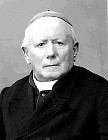
(7) 7. SALIÈGE, Jules-Géraud
(1870-1956)
Birth. February 24, 1870, Mauriac, diocese of Saint-Flour, France. Son of M. Saliège and Marie-Antoinette Monteil. He was the fourth of five children of a family of the rural bourgeoisie of his native city. His siblings were Marcelin, Antony, Marie and Léonie. His father died when he was twelve years old. He had two uncles who were priests and two aunts who were religious. His middle name is also listed as Gérauld.
Education. His maternal uncle, Father Jules Monteil, took charge of his education. He studied at the Minor Diocesan Seminary of Pleaux, Cantal (baccalaureate in philosophy). Then, he entered the Seminary of Issy-les-Moulineaux, Paris. He was noted for his oratory talent. Received the subdiaconate on December 22, 1894.
Priesthood. Ordained, September 21, 1895, chapel of the bishop of Saint-Flour. Faculty member of the Minor Diocesan Seminary of Pleaux, 1895-1903. Spiritual director at the Carmelite convent of Saint-Flour. He was never in charge of a parish. Faculty member of the Seminary of Saint-Flour, 1903-1907; its rector, 1917-1925. Honorary canon of the cathedral chapter of Saint-Flour, September 14, 1905; honorary vicar general, March 31, 1918. During the First World War, he was mobilized as a military nurse on August 5, 1914; he was attached to the 163rd Infantry Division. At his request, on May 5, 1916, he was given the function of voluntary chaplain in the sector of Esparges and Mount Cornillet. His conduct during the war earned him a citation of Order du Jour de l'Armée on August 23, 1917. At the end of 1917, at the request of Bishop Paul Lecœur of Saint-Flour, he was demobilized from the army; he had been affected by pepper gas.
Episcopate. Elected bishop of Gap, October 29, 1925. Consecrated, January 6, 1926, cathedral of Saint-Flour, by Paul-Augustine Lecœur, bishop of Saint-Flour, assisted by Benjamin Roland-Gosselin, titular bishop of Mosinopoli, auxiliary of Paris, and by Hippolyte de La Celle, bishop of Nancy. His episcopal motto was Sub umbra illius. Promoted to the metropolitan see of Toulouse, December 17, 1928. On August 23, 1942, during the Second World War, he publicly and strongly protested the deportation of the Jews and for this, he was later honored in the Yad Vashem (Holocaust Martyrs' and Heroes' Remembrance Authority) as a "Righteous among the Nations". By decree of August 7, 1945, he was named Compagnon de la Libération. Assistant at the Pontifical Throne, October 15, 1945.
Cardinalate. Created cardinal priest in the consistory of February 18, 1946; received the red hat and the title of S. Pudenziana, May 17, 1946. On February 18, 1946, he was decorated with the Croix de la Libération by Pierre Bertaux, commissary of the French Republic. He was an enemy of all totalitarianisms: Communism, Fascism and Nazism. He had prepared his testament on April 4, 1943, and in it, he stated that he wanted a stone over his grave with the simple inscription: "Dilexit Ecclesiam".
Death. November 5, 1956, Toulouse, of a congestion (1). The funeral took place on November 10, 1956, in Saint-Étienne's metropolitan cathedral, Toulouse, celebrated by Cardinal Maurice Feltin, archbishop of Paris, and in the presence of all the other French cardinals; numerous archbishops and bishops; the prefect of Haute-Garonne; the honorary president of the French Republic, Vincent Auriol; the president of the honorary Council, Georges Bidault; and other official representatives. The body of the cardinal received military honors before the door of Saint'Anne of the metropolitan cathedral. Buried in the metropolitan cathedral of Toulouse (2). Shortly after the burial, his cardinal hat was hung from the ceiling of the cathedral over his tomb. In 1969, Yad Vashem recognized him as a Just aming Nations for his efforts in defense of the Hebrew people during the Nazi occupation of France. In a small public garden, next to the metropolitan cathedral of Toulouse, a bronze bust of the cardinal was placed in November 1986, on the thirtieth anniversary of his death. A square next to the cathedral of Saint-Étienne was dedicated to his memory by the city of Toulouse on May 12, 2015.
Bibliography. Le cardinal Saliège, archevêque de Toulouse. Actes du colloque des 3 et 4 novembre 2006 à l'occasion du cinquantième anniversaire de la mort du cardinal Saliège. Toulouse :Institut catholique de Toulouse, 2007; Chapeau, O.S.B. André and Fernand Combaluzier, C.M. Épiscopologe français des temps modernes, 1592-1973. Paris : Letouzey et Ané, 1974, p. 483-484; Chansou, Joseph. Sous l'épiscopat du cardinal Saliège : 1929-1956, contribution à l'histoire du diocèse de Toulouse. Toulouse (2, rue Deville, 31000) : J. Chansou, 1978; Chansou, Joseph. Sous l'épiscopat du cardinal Saliège : 1929-1956. Baziège : Pélé jeunes région, 2006; Clément, Jean-Louis. Monseigneur Saliège, archevêque de Toulouse : 1929-1956. Paris : Beauchesne, Impr. des Presses universitaires de France), 1994. Dissertation: Texte remanié de Th. doct. Histoire Paris IV 1990. (Bibliothèque Beauchesne, 23); Commémoration du XXXe anniversaire de la mort du Cardinal Saliège (1956-1986). [Toulouse] : Institut Catholique de Touluse, 1987. (Supplément au Bulletin de littératurue ecclésiastique; Chronique, no. 2, 1987. Other title: Commémoration du trentième anniversaire de la mort du Cardinal Saliège (1956-1986); Guitton, Jean. Le Cardinal Saliège. Paris : Bernard Grosset, 1957; Saliège, Jules Géraud. Spiritual writings [by] Cardinal Saliège; an anthology chosen and presented by Archbishop Garrone. Langley (Bucks.) : St. Paul Publications, 1966. Note: Originally published as Ècrits spirtuels. Paris, Grasset, 1960. Translated [from the French] by Malachy G. Carroll; Sandy, Isabelle ; Dufaur, Marguerite. De granit et de pourpre : le cardinal Saliège. Paris : Spes, 1957; Vié, Louis. Le cardinal Saliège, archevêque de Toulouse, 1870-1956. Toulouse : Semaine catholique, 1956. Note: "Articles ... publiés par la Semaine catholique de Toulouse, dans ses numéros des 11 et 18 nov. 1956".
Webgraphy. His arms, Araldica Vaticana; Monsignor Jules-Gérard Saliège, France, Yad Vashem The Holocaust Martyrs' and Heroes' Remembrance Authority; Le cardinal Saliège, un Juste à l'honneur, La Croix, 11/7/12 - 16 H 47; Lo Yad Vashem onora il coraggio dell'arcivescovo Saliège / A settant'anni dal rastrellamento nazista a Parigi, from L'Osservatore Romano, Il Sismografo, venerdì 13 luglio 2012; R.I.P la rafle du Vel' d'Hiv'..., InfoCatho.be, 2012/07/17; Judíos reconocen labor de Cardenal francés que plantó cara a los nazis en su defensa, ACI/EWTN Noticias, Vaticano, 23 Jul. 12 / 07:19 am; Il vescovo muto che ruppe il silenzio. Jules-Geraud Saliege di fronte alla persecuzione degli ebrei by Charles de Pechpeyrou, L'Osservatore Romano, 27 gennaio 2017; Il Cardinale Saliège, un Giusto tra le Nazioni by Marco Mancini, ACI Stampa, Tolosa, 05 novembre, 2021 / 2:00 PM; «Et clamor Jerusalem ascendit». Ottant’anni fa la lettera di monsignor Saliège by Charles de Pechpeyrou, L'Osservatore Romano, 23 agosto 2022
(1) These are the texts of telegrams of condolence, taken from Guitton, Le Cardinal Saliège, p. 323, sent in the name of Pope Pius XII to Archbishop Gabriel Marie Garrone, coadjutor of Toulouse:
Sa Sainteté douloureusement affectée décès trés regretté cardinal Saliège, recommande divine miséricorde âme éminent pasteur dont elle appréciait hautement zéèle et énergie service Église. Envoie Votre Excellence, clergé et tout diocèse en deuil réconfort, paternelle Bénédiction apostolique.
By President René Coty of France:
Bien ému du décès du grand Prince de l'Église qui fut toujours et spécialement aux heures les plus sombres un modèle de patriotisme et de courage; je vous prie d'agréer pour vous-même, Monseigneur, et pour le diocèse de Toulouse, l'expression de ma sympathie profondément attristée
And by Cardinal Joseph Frings, archbishop of Cologne, Germany:
Du fond du coeur je m'unis au deuil du diocèse de Toulouse. Créé cardinal par le Saint-Père en même temps que S. Em. le cardinal Saliège, je n'ai cessé d'avoir pour l'extrême pénétration de son esprit, son héroïque patience, sa très profonde piété, un sentiment d'admiration. J'ai offert le Saint Sacrifice pour le repos de son âme.
(2) This is the inscription on his tomb, taken from Guitton, Le Cardinal Saliège, p. 330:
Julius Geraldus Saliège Preb. Tit. S. Pudentianæ S. R. E. cardinalis Archiepiscopus tolosanus, doctrina clarus et fortitudine ovibus deditus, defensor civitatis obiit nonis novembris an. MDCCCCLVI

(8) 8. MCGUIGAN, James Charles
(1894-1974)
Birth. November 26, 1894, Hunter River, diocese of Charlottetown, Prince Edward Island, Canada. Son of George Hugh McGuigan and Anne Monaghan. He was baptized at St. Augustine's church, South Rustico by Rev. Ronald MacDonald. Received first communion from Monsignor Jean Chaisson; and the sacrament of confirmation at St. Augustine's Church from James Charles MacDonald, bishop of Charlottetown.
Education. Studied at Prince of Wales College, Charlottetown; Saint Dunstan's University, Charlottetown; University of Laval, Québec, where he earned a bachelor's in arts, in 1914; later, at the Grand Seminary of Québec, Québec, obtaining doctorates in philosophy and theology, in 1918; and at The Catholic University of America, Washington, D.C.
Priesthood. Ordained, May 26, 1918, in his native parish of St Augustine's, by Louis James O'Leary, bishop of Charlottetown. Faculty member of Saint Dunstan's University and secretary to the bishop of Charlottetown, 1918-1920; secretary to the archbishop of Edmonton, 1920-1922. Chancellor of the archdiocese of Edmonton, 1922-1923; vicar general, 1923-1930. Protonotary apostolic, September 13, 1927. Pastoral ministry in the archdiocese of Edmonton, 1925-1927. Rector of Saint Joseph's Seminary, Edmonton, 1927-1930.
Episcopate. Elected archbishop of Regina, January 30, 1930. Consecrated, May 15, 1930, cathedral of Saint Joseph, Edmonton, by Henry Joseph O'Leary, archbishop of Edmonton, assisted by Arthur Béliveau, archbishop of Saint Boniface, and by John Thomas Kidd, bishop of Calgary. His episcopal motto was Ambulate in dilectione. Transferred to the metropolitan see of Toronto, December 22, 1934. Assistant at the Pontifical Throne, August 20, 1943.
Cardinalate. Created cardinal priest in the consistory of February 18, 1946; received the red hat and the title of S. Maria del Popolo, February 22, 1946. First English speaking cardinal from Canada. Papal legate to the National Marian Congress, Ottawa, March 25, 1947. Participated in the conclave of 1958, which elected Pope John XXIII. Attended the Second Vatican Council, 1962-1965. Participated in the conclave of 1963, which elected Pope Paul VI. Resigned the pastoral government of the archdiocese, March 30, 1971.
Death. April 6, 1974, from a heart attack, Toronto. Buried, April 15, 1974, in the priest's plot, south of Saint Augustine's Seminary, Toronto (1).
Bibliography. Code, Bernard. Dictionary of the American Hierarchy (1789-1964). New York : Joseph F. Wagner, 1964, p. 441; LeBlanc, Jean. Dictionnaire biographique des évêques catholiques du Canada. les diocèses catholiques canadiens des Églises latine et orientales et leurs évêques; repères chronologiques et biographiques, 1658-2002. Ottawa : Wilson & Lafleur, 2002. (Gratianus. Série instruments de recherche), pp. 650-652.
Webgraphy. Photograph and biography, in English, archdiocese of Toronto; his photograph and arms, Araldica Vaticana.
(1) The chapel in which among others are the remains of Cardinal McGuigan in the cemetery located on the grounds of St. Augustine Seminary has on its exterior walls the following inscription in his memory, kindly provided by Mr. Eman Bonnici, from Malta::
IN YOUR PRAYERS KINDLY REMEMBER HIS EMINENCE JAMES C · CARDINAL MCGUIGAN NOV·26·1894 · APRIL 8·1974 ARCHBISHOP OF TORONTO 1934 · 1971 REQUIESCANT
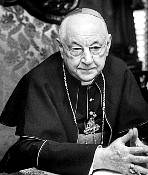
(9) 9. STRITCH, Samuel Alphonse
(1887-1958)
Birth. August 17, 1887, Nashville, Tennessee, United States of America. Son of Garret Stritch, manager of Sycamore Mills in Nashville, and Katherine O'Malley. He had two brothers, Robert and Eugene, and five sisters.
Education. Studied at Saint Gregory's Preparatory Seminary, Cincinnati; and at the Pontifical Urbanian Athenaeum "De Propaganda Fide," Rome, residing at the Pontifical North American College, Rome.
Priesthood. Ordained, May 21, 1910, patriarchal Lateran basilica, Rome, by Cardinal Pietro Respighi, vicar of Rome. Pastoral ministry in the diocese of Nashville, 1910-1916. Secretary to the bishop of Nashville, 1916-1917. Diocesan chancellor of Nashville, 1917-1921. Domestic prelate of His Holiness, May 10, 1921.
Episcopate. Elected bishop of Toledo, Ohio, August 10, 1921. Consecrated, November 30, 1921, cathedral of St. Francis de Sales, Toledo, by Henry Moeller, archbishop of Cincinnati, assisted by John Baptist Morris, bishop of Little Rock, and by Thomas Edmund Molloy, bishop of Brooklyn. His episcopal motto was Deus meus adjutor meus. Promoted to the metropolitan see of Milwaukee, August 26, 1930. Transferred to the metropolitan see of Chicago, December 27, 1939.
Cardinalate. Created cardinal priest in the consistory of February 18, 1946; received the red hat and the title of S. Agnese fuori le mura, February 22, 1946. President of the 9th National Catechetical Congress, Chicago, September 14, 1951. Pro-prefect of the S.C. for Propagation of Faith, March 1, 1958 until his death. Because his right arm had an occlusion of its main artery, it had to be amputated above the elbow; after the operation, he suffered a stroke on May 18, 1958, and died eight days later.
Death. May 26, 1958, at 7.35 pm, in the "Sanatrix Clinic", Rome. His body was first laid out in state at the North American Pontifical College until being transferred to the church of S. Ignazio where a funeral mass was celebrated with Cardinal Eugène Tisserant, dean of the Sacred College of Cardinals, giving the final absolution. His body was later flown to the United States of America. An estimated 48,000 walked past his bier as he was laid out in state at the Holy Name Cathedral. The solemn pontifical requiem mass was celebrated at that cathedral by Amleto Giovanni Cicognani, titular archbishop of Laodicea di Frigia, apostolic delegate to the United States of America. Cardinals Francis Joseph Spellman, Edward Aloysius Mooney and James Francis McIntyre were in attendance, along with 100 other prelates. Some 8000 people participated in the requiem mass and cortege which followed to the cemetery. He was buried on June 3, 1958, in the bishops' chapel, Mount Carmel Cemetery, Hillside, archdiocese of Chicago (1). His successors Cardinals John Patrick Cody and Joseph Louis Bernardin are also buried in that chapel.
Bibliography. Buehrle, Marie Cecilia. The Cardinal Stritch story. Milwaukee: The Bruce Publishing Co., 1959; Code, Bernard. Dictionary of the American Hierarchy (1789-1964). New York : Joseph F. Wagner, 1964, p. 278-279; Thornton, Francis Beauchesne. Our American princes. The story of the seventeen American cardinals. New York : G.P. Putnam's Sons, 1963, pp. 186-200; Pięta, Zenonem. Hierarchia Catholica Medii et Recientoris Aevi. Volumen IX (1903-1922). Patavii : Typis et Sumptibus Domus Editorialis "Il Messaggero di S. Antonio" apud Basilicam S. Antonii, 2002, p. 372.
Webgraphy. His photograph and biography, in English, archdiocese of Milwaukee; his photographs and arms, Araldica Vaticana.
(1) This is the text of the inscription on his tomb, kindly provided by Mr. Eman Bonnici, from Malta:
HERE, AWAITING THE RESURRECTION, LIE THE REMAINS OF HIS EMINENCE SAMUEL ALPHONSUS CARDINAL STRITCH FOURTH ARCHBISHOP OF CHICAGO PRO-PREFECT OF THE SACRED CONGREGATION FOR THE PROPAGATION OF THE FAITH 1958 BORN, NASHVILLE, TENN., AUG. 17. 1887 ARCHBISHOP OF MILWAUKEE, 1930-1939 ORDAINED, ROME, ITALY, MAY 21, 1910 ARCHBISHOP OF CHICAGO, 1939-1958 BISHOP OF TOLEDO, 1921-1930 DIED, ROME, ITALY, MAY 27, 1958 BEHOLD A GREAT PRIEST, WHO IN HIS DAY WAS PLEASING TO GOD. MAY HE REST IN PEACE.
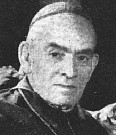
(10) 10. PARRADO Y GARCÍA, Agustín
(1872-1946)
Birth. October 5, 1872, Fuensaldaña, archdiocese of Valencia, Spain. Seventh child of José Parrado Gobernado (1834-?) and Pascuala García Fraga (1835-?), humble farmers.
Education. Studied at the Seminary of Valladolid.
Priesthood. Ordained, September 21, 1895, Valladolid. Successively, 1895-1925, faculty member of the Seminary of Valladolid and of the Pontifical University of Valladolid; vice-rector of Seminary of Valladolid; canon penitentiary of cathedral chapter of Astorga; director of the diocesan newspaper of Astorga; diocesan official of Astorga; diocesan official of Salamanca and dean of the theological faculty of the Pontifical University of Salamanca. Domestic prelate of His Holiness, June 14, 1922.
Episcopate. Elected bishop of Palencia, May 20, 1925. Consecrated, August 16, 1925, cathedral of Salamanca, by Julián de Diego García, patriarch of Western Indies and military vicar general, assisted by Manuel de Castro y Alonso, bishop of Segovia, and by Manuel María Vidal y Boullón, bishop of Tuy. His episcopal motto was Tibi post haec, fili mi, ultra quid faciam. Promoted to the metropolitan see of Granada, April 4, 1934. Assistant at the Pontifical Throne, October 17, 1945.
Cardinalate. Created cardinal priest, February 18, 1946; received the red hat and the title of S. Agostino, February 22, 1946.
Death. October 8, 1946, at 7 a.m., from a lung injury complicated by hemothorax, in Granada. Buried in front of the main altar of the Church of Nuestra Señora de Gracia in Granada (1).
Bibliography. Echeverría, Lamberto de. Episcopologio español contemporáneo, 1868-1985 : datos biográficos y genealogía espiritual de los 585 obispos nacidos o consagrados en España entre el 1 de enero de 1868 y el 31 de diciembre de 1985 . Salamanca : Universidad de Salamanca, 1986. (Acta Salmanticensia; Derecho; 45), p. 87.
Webgraphy. Biography by Vicente Cárcel Ortí, in Spanish, Diccionario Biográfico Español, DB~e; biography, in Spanish, Wikipedia; his arms and photograph, Araldica Vaticana.
(1) This is the text of the inscription on his vault, kindly provided by Mr. Eman Bonnici, from Malta:
A ⳩ Ω AVGVSTINVS S·R·E·PRESBYTER·CARDINALIS PARRADO·Y·GARCIA ARCHIEP·GRANATEN· OBIIT IN·PACE·⳩ DIE·VIII·OCT·AN·MDCCCCXLVI CVIVS·HEIC OSSA·ET·CINERES RESVRRECTIONEM·EXSPECTANT ORATE·PRO·EO.
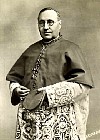
(11) 11. ROQUES, Clément-Émile
(1880-1964)
Birth. December 8, 1880, Saint Pierre des Ports, Graulhet, archdiocese of Albi, France. Son of Philippe Roques and Victorine Raphe.
Education. He studied at the Minor Seminary of Lavaur; then, at the Seminary of Albi; and finally, at the Catholic Institute, Toulouse.
Priesthood. Ordained, April 2, 1904, Rodez. Faculty member, administrator, prefect of studies, and superior of the Seminary of Barral, Castres, 1904-1929.
Episcopate. Elected bishop of Montauban, April 15, 1929. Consecrated, June 24, 1929, metropolitan cathedral of Albi, by Pierre-Celestin Cézerac, archbishop of Albi, assisted by Jules-Géraud Saliège, archbishop of Toulouse, and by Charles Challiol, bishop of Rodez. His episcopal motto was In fide et lenitate. Promoted to the metropolitan see of Aix, December 24, 1934. Transferred to the metropolitan see of Rennes, May 11, 1940.
Cardinalate. Created cardinal priest in the consistory of February 18, 1946; received the red hat and the title of S. Balbina, February 22, 1946. Papal legate to the National Eucharistic Congress, Nantes, June 6, 1947; to the National Eucharistic Congress, Rennes, June 22, 1956. He was decorated with the Légion d’Honneur on July 21, 1958. Participated in the conclave of 1958, which elected Pope John XXIII. Attended the first two sessions of the Second Vatican Council, 1962-1963. Participated in the conclave of 1963, which elected Pope Paul VI.
Death. September 4, 1964, Rennes. Buried in the metropolitan cathedral of Rennes (1).
Bibliography. Chapeau, O.S.B. André and Fernand Combaluzier, C.M. Épiscopologe français des temps modernes, 1592-1973. Paris : Letouzey et Ané, 1974, p. 473-474.
Webgraphy. His photograph and arms, Araldica Vaticana.
(1) This is the text of the inscription on his cenotaph, kindly providedd by Mr. Eman Bonnici, from Malta:
+ VEUILLEZ PRIER POUR LE REPOS ETERNEL DE L’AME DE SON EMINENCE MONSEIGNEUR LE CARDINAL CLEMENT EMILE ROQUES NE A GRAULHET (TARN) LE 8 DECEMBRE 1880 EVEQUE DE MONTAUBAN 1929-1934 ARCHEVEQUE D’AIX 1934-1940 ARCHEVEQUE DE RENNES, DOL ET SṬ MALO-1940-1964 OFFICIER DE LA LEGION D’HONNEUR DECEDE LE 4 SEPTEMBRE 1964
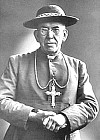
(12) 12. JONG, Jan de
(1885-1955)
Birth. September 10, 1885, Nes, Ameland Island, archdiocese of Utrecht, Holland. He was the eldest of the eight children of Jan de Jong, baker and farmer, and Trijntje Mosterman.
Education. Studied at the Minor Seminary of Culemborg, 1898-1904; at the Seminary of Rijsenburg, Utrecht, 1904-1908; at the Pontifical Gregorian University, Rome; at the Pontifical Roman Academy of Saint Thomas Aquinas, Rome; obtained doctorates in philosophy and theology.
Priesthood. Ordained, August 15, 1908, Rome. Further studies, 1908-1912. Assistant pastor in the parish church in Amersfoort, 1912-1913; co-rector of the mother house and pensionate of little girls at the Sisters of Mercy, Amersfoort, 1913-1914. Faculty member of the Seminary of Rijsenburg, November 6, 1914-1931; its rector, August 14, 1931-1935. Canon of the cathedral chapter of Utrecht, 1933-1935.
Episcopate. Elected titular archbishop of Rusio and appointed coadjutor of Utrecht, with right of succession, August 3, 1935. Consecrated, September 12, 1935, metropolitan cathedral of Utrecht, by Pieter Adriaan Willem Hopmans, bishop of Breda, assisted by Arnold Franciscus Diepen, bishop of `s-Hertogenbosch, and by Hendrik Jan Smit, titular bishop of Paralus and former vicar apostolic of Norway. His episcopal motto was Dominus mihi adiutor. Succeeded to the metropolitan see of Utrecht, February 6, 1936. Leader against the Nazi occupation of Holland during the Second World War.
Cardinalate. Created cardinal priest in the consistory of February 18, 1946; received red hat and title of S. Clemente, October 12, 1946 (1). Papal legate to the National Marian Congress, Maastricht, Holland, August 15, 1947. Left the administration of the archdiocese to a coadjutor in 1951 and retired to the same house where he had worked as a co-rector in Amersfoort.
Death. September 8, 1955, in his sleep, after a long illness, in Amersfoort. Buried in St. Barbara cemetery, in the court of St. Catharina metropolitan cathedral, Utrecht (2). On April 22, 1971 in the Catharijne convent a peace vault was inaugurated in memory of Cardinal Jong, the leader of the Dutch Roman Catholic Church province during the Second World War. On September 3, 1982, Cardinal Johannes Willebrands unveiled a statue of his predecessor in Ameland. In Saint Clemenskerk of Nes, a stained glass window was installed and at the entrance of the church, a plaque was placed in his memory.
Bibliography. Schaik, Ton H. M. van. Aartsbisschop in oorlogstijd : een portret van Kardinaal de Jong (1885-1955). Baarn : Gooi en Sticht, 1996; Spiertz, M. G. "Jan de Jong." Biografisch woordenboek van Nederland. 3 v. 's-Gravenhage : Nijhoff, 1979-1989, II, 259-262.
Webgraphy. Biographical data, in Dutch, Stichting Archief- en Documentatiecentrum voor R.K. Friesland, p. 3; his episcopal lineage by Mr. Charles N. Bransom, Jr,, in English, Apostolic Succession in the Roman Catholic Church; and photographs and arms, Araldica Vaticana; and photographs, to access them type "de Jong" in "Titel afbeelding", Stichting Archief- en Documentatiecentrum voor R.K. Friesland; biography, in English, Wikipedia.
(1) Cardinal John Joseph Glennon, who was promoted to the cardinalate in the same consistory, received the title of S. Clemente on February 22, 1946, but he died on the following March 9, and then Cardinal Jong was assigned the same title.
(2) This is the inscription on his tomb, kindly provided by Mr. Eman Bonnici from Malta:
JOHANNES KARDINAAL DE JONG AARTSBISSCHOP VAN UTRECHT * 10 - 9 - 1885 + 8 - 9 - 1955
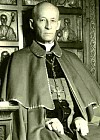
(13) 13. MOTTA, Carlos Carmelo de Vasconcelos
(1890-1982)
Birth. July 16, 1890, Bom Jesus do Amparo, archdiocese of Mariana, Brazil. Second child of João de Vasconcelos Teixeira da Motta, a deputy during the empire, and Francisca Josina dos Santos Motta. He was born prematurely after a seven months pregnancy. He was a great-grandson of the Viscounts of Caeté.
Education. Initial studies at Fazenda da Prata, in the parish of Taquaraçu, Caeté, Minas Gerais; Colégio Matosinhos, of the Marist Brothers, in Congonhas do Campo (humanities); in 1904, he entered the Minor Seminary of Mariana and stayed there for a brief period; studied at the Faculty of Law of Belo Horizonte, 1910-1911; studied at the Major Seminary of Mariana, Mariana, 1914-1918.
Priesthood. Ordained, June 20, 1918, Mariana, by Silvério Gomes Pimenta, archbishop of Mariana; celebrated his first Mass in Taquaruçu, on July 7, 1918. Vicar coadjutor of Taquaraçu for eleven months; named chaplain of Asilo São Lums da Serra da Piedade; later, he was chaplain of Recolhimento das Macaúbas and worked in the parishes of Caeté and Sabará. Shortly after being ordained, he received an invitation from Venceslau Brás, then President of Brazil, to run for federal deputy but he declined to continue his work in the parishes of Caeté and Sabará. Finally, he was named rector of Coração Eucarístico Archdiocesan Seminary of Minas Gerais in 1932. Privy chamberlain of His Holiness, October 23, 1925.
Episcopate. Elected titular bishop of Algiza and appointed auxiliary of Diamantina, July 29, 1932. Consecrated, October 30, 1932, in the church of São José, Belo Horizonte, by António dos Santos Cabral, bishop of Natal, assisted by Ranulfo da Silva Farias, bishop of Guaxupé, and by Antonio Colturato, O.F.M. Cap., bishop of Uberaba. His episcopal motto was In sinu Iesu. Administrator of the diocese of Diamantina, 1933-1934. Promoted to the metropolitan see of São Luis do Maranhão, December 19, 1935. During his episcopate in Maranhão, he created 29 new parishes; renovated the cathedral and inaugurated the Marist College, to whom he ceded the archiepiscopal palace to enable their initial functioning before buying for them a 40 thousand square meters area known as Quinta do Barão das Laranjeiras in Rua Grande, where he had constructed a majestic building to meet the enrollment demand for primary, junior, high and scientific classes. Promoted the creation of the sees of Caxias and Pinheiros; was administrator of the latter from 1940 until 1944. Transferred to the metropolitan see of São Paulo, August 13, 1944; he established more than one hundred new parishes.
Cardinalate. Created cardinal priest in the consistory of February 18, 1946; received the red hat and the title of S. Pancrazio, February 22, 1946. On March 18, 1946, he established the Paulista Faculty of Law, initial nucleus of the the Catholic University of São Paulo on September 2, 1946; in 1947, Pope Pius XII granted it the rank of pontifical university. Presided over the 7th centennial celebrations of the Carmelite scapulary, Recife, July 6, 1951. First president of the Episcopal Conference of Bishops of Brazil from 1952 to 1958. Attended the First General Conference of the Latin American Episcopate, Rio de Janeiro, Brazil, July 25 to August 4, 1955. The weekly review of the Archdiocese of São Paulo, the Jornal o São Paulo, which saw its first edition on January 25, 1956, was founded by him. On March 2, 1956, he founded Rádio Nove de Julho, in commemoration of the 80th birthday of Pope Pius XII. He personally selected the name of Brasilia for the new federal capital city and celebrated there the first Mass on May 3, 1957. Administrator of the archdiocese of Aparecida since its establishment on April 19, 1958 until April, 1964. Participated in the conclave of 1958, which elected Pope John XXIII. Attended the Second Vatican Council, 1962-1965. Participated in the conclave of 1963, which elected Pope Paul VI. Transferred to the metropolitan see of Aparecida as its first archbishop, April 18, 1964; he built the National Shrine of Nossa Senhora Aparecida, the patroness of Brazil. Lost the right to participate in the conclave by being older than eighty years, January 1, 1971. Cardinal protoprete, October 23, 1979. Suffering from bronchopneumonia for the last three weeks of his life, which left him in and out of consciousness, he ultimately succumbed to arteriosclerosis. Six hours before his death, he received the sacrament of the extreme unction from his successor, Dom Geraldo María de Morais Penido, along with a special blessing from Pope John Paul II.
Death. September 18, 1982, at 2:10 a.m., in Santa Casa de Misericórdia, Aparecida. Laid out in state as of the following 6 am., in the Old Basilica of Aparecida, where Masses for his suffrage were held every two hours; his body was transported to the Cathedral Basilica of the National Shrine of Our Lady Aparecida in a cortege formed by some 6,000 people on foot. The funeral Mass was celebrated at the metropolitan cathedral basilica of Aparecida with the participation of Cardinal Eugénio de Araújo Sales, archbishop of São Sebastião do Rio de Janeiro; Cardinal Vicente Scherer, former archbishop of Porto Alegre; Luciano Pedro Mendes de Almeida, S.J., titular bishop of Torre di Proconsulare, auxiliary of São Paulo and secretary general of the National Conference of Brazilian Bishops (NCNBB); and twenty seven other bishops. The homily was delivered by Alexandre Gonçalves do Amaral, archbishop emeritus of Uberaba. Buried in the Chapel do Santíssimo, in the metropolitan cathedral of Aparecida, in a specially constructed sarcophagus. At his death, he was the oldest member of the Sacred College of Cardinals.
Bibliography. "Carlos Carmelo de Vasconcelos Mota" in "Terceira parte, Bispos do Brasil-Republica, Os cinco primeiros cardeais" in "Diocesis e bispos do Brasil" by Apolônio Nóbrega, Revista do Instituto Histórico e Geográfico Brasileiro, volume 222, Janeiro-Março 1954, 196-197; Vidigal, Pedro Maciel. O Cardeal de Vasconcellos Motta. Belo Horizonte: Imp. Oficial, 1973.
Webgraphy. Biography, in Portuguese, archdiocese of São Paulo; his photograph and arms, Araldica Vaticana.
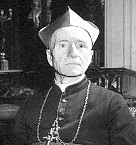
(14) 14. PETIT DE JULLEVILLE, Pierre
(1876-1947)
Birth. November 22, 1876, Dijon, France. His father, Louis Petit de Julleville, was a professor at the Faculty of Letters of Dijon; his mother's maiden name was Marty-Laveaux; he was the fourth of five children; he had three older sisters, Catherine, Marguerite and Madeleine; and a younger one, Geneviève. His baptismal name was Pierre-André-Charles. His father became professor at École Normale Supérieure of Paris and the family moved to that city when Pierre was still a young boy.
Education. Initial studies, when he was eight years old, at Lycée Janson-de-Sailly, Paris; La Sorbonne University, Paris, 1893-1896 (licentiate in history); military service, November 1897 to September 1898, in the 28th infantry regiment in Èvreaux; continued his studies at the Seminary of Saint-Sulpice, Paris, October 13, 1899 to 1903; received the ecclesiastical tonsure. He was ordained to the subdiaconate and diaconate (December 22, 1902) by Félix-Jules-Xavier Jourdan de La Passardière, Orat., titular bishop of Rosea.
Priesthood. Ordained, July 4, 1903, church of Saint-Sulpice, Paris, by Bishop Jourdan de La Passardière; he celebrated his first Mass at the church of La Sorbonne University. Further studies, 1903-1905, Procure de Saint-Sulpice, Rome. Faculty member of the Grand Seminary of Issy Paris, 1905-1910. Canon of the cathedral chapter and superior the of School of Sainte-Croix-de-Neuilly, Neuilly, 1910-1914; 1918-1927. Military chaplain in the First World War, 1914-1918.
Episcopate. Elected bishop of Dijon, June 23, 1927. Consecrated, September 29, 1927, metropolitan cathedral of Paris, by Cardinal Louis-Ernest Dubois, archbishop of Paris, assisted by Louis Gaillard, bishop of Meaux, and by Georges Audollent, bishop of Blois. His episcopal motto was Caritate in pace et Christi. Promoted to the metropolitan see of Rouen, August 7, 1936. Apostolic administrator of the see of Dijon, September 18, 1936 to May 15, 1937.
Cardinalate. Created cardinal priest, February 18, 1946; received the red hat and the title of S. Maria in Aquiro, deaconry elevated pro illa vice to title, February 22, 1946.
Death. Wednesday December 10, 1947, at 1:15 a.m., from complications of a cold, after receiving holy communion and the extreme unction, Rouen. The obsequies took place on December 18 in the presence of Cardinals Achille Liénart, Emmanuel Suhard, Pierre-Marie Gerlier and Clément-Émile Roques; the apostolic nuncio, Angelo Giuseppe Roncalli, and all the bishops of the ecclesiastical province, as well as high civil authorities from the national, regional and local governments. Buried in the chapel of the Virgin in the apse of the metropolitan cathedral of Rouen (1). A street in his native Dijon and a square in the 17th Arrondissement of Paris, near the Institution Notre-Dame de Sainte-Croix which he once led, were named after him.
Bibliography. Brain, Roger. Le Cardinal Petit de Julleville. Paris: Centre de documentation sacerdotale, 1948; Chapeau, O.S.B. André and Fernand Combaluzier, C.M. Épiscopologe français des temps modernes, 1592-1973. Paris : Letouzey et Ané, 1974, p. 443-444; De la Serre, René. Le Cardinal Petit de Julleville. Paris: Librairie Plon, 1955.
Webgraphy. Photograph, arms and biography, in French, Wikipédia; his arms, Araldica Vaticana.
(1) This is the text of his cenotaph in the metropolitan cathedral of Rouen, kindly provided by Mr. Eman Bonnici, from Malta:
PETRVS PETIT · DE · JVLLEVILLE ARCHIEPISC · ROTOMAGEN · NORMANN · PRIMAS S · R · E · PRESBYTER · CARDINALIS E · DIVIONEN · AD · HANC · SEDEM · PROMOTVS AN · M · CM · XXXVI OVIVM · PASTOR · INDEFESSVS · ET · AGNORVM CLERI · DVM · SE · PRAEBET · FORMAM GNAVVM · LAICORVM · GREGEM · AD · AGENDVM AVSPICE · PIO · XI · PONT · MAX · PRO · CONSORTIBVS · VERA · FIDE · INLVMINANDIS STRENVE · PROVOCAVIT INFAVSTO · PATRIA · CASV · INTER · ARMA · COMMINVTA ALIENIGENAM · ADVORSVM · MILITEM IN · RVINA · CIVITATIS ILLO CVM · TEMPLO · METROPOLIT · FERRO · VASTATAE · ET · IGNI INTREPIDVS · ERECTO · STETIT · CAPITE SACRA · TVM · DONATVS · PVRPVRA AT · LABORE · VIGILIIS · MORBO · CONFECTVS IN · PACE · ET · CARITATE · CHRISTI VTI · VITAM · GESSERAT OBIIT · IV · ID · DECEMBRES · AN · M · CM · XLVII AETATIS · SVAE · LXXI CVIVS · ANIMA · LVCE · FRAVTRVR · AEVI · SEMPITERNI
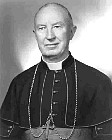
(15) 15. GILROY, Norman Thomas
(1896-1977)
Birth. January 22, 1896, Glebe, Sydney, Australia. Second of the six children of William James Gilroy, a tailor's cutter, and Catherine Slattery. They both were Australians of Irish extraction. The other two brothers were Ted and William, and the three sisters, Ellen, Rita and Catherine.
Education. Initial studies with the Marist priests in Sydney (1); then, attended St. Columba's College, Springwood, Sydney, 1916-1919; and finally, the Pontifical Urbanian Athenaeum "De Propagada Fide," Rome, 1919-1924, where he earned a doctorate in theology in 1924.
Priesthood. Ordained, December 24, 1923, Rome, by Cardinal Willem Marinus van Rossum, C.SS.R., prefect of the S.C. for the Propagation of the Faith. Returned to Australia and became secretary to the apostolic delegate, Bartolomeo Cattaneo, titular archbishop of Palmira, 1924-1930. Secretary to the bishop of Lismore and diocesan chancellor, 1930-1935.
Episcopate. Elected bishop of Port Augusta, Australia, December 10, 1934. Consecrated, March 17, 1935, St. Mary's cathedral, Sydney, by Filippo Bernardini, titular archbishop of Antiochia di Pisidia, apostolic delegate in Australia, assisted by John Joseph Carroll, bishop of Lismore, and by Terence Bernard McGuire, bishop of Townsville. His episcopal motto was Christus lux mea. Promoted to titular archbishop of Cipsela and appointed coadjutor of Sydney, with right of succession, July 1, 1937. Succeeded to the metropolitan see of Sydney, March 8, 1940.
Cardinalate. Created cardinal priest in the consistory of February 18, 1946; received the red hat and the title of Ss. Quattro Coronati, February 22, 1946. Papal legate to the 4th centennial celebrations of Saint Francis Xavier's arrival at Nagasaki, Japan, April 17, 1949; to the Plenary Council of the Eastern Indies, Bangalore, India, November 7, 1949. Participated in the conclave of 1958, which elected Pope John XXIII. Attended the Second Vatican Council; member of its board of presidency, 1962-1965. Participated in the conclave of 1963, which elected Pope Paul VI. Attended the First Ordinary Assembly of the Synod of Bishops, Vatican City, September 29 to October 29, 1967; the First Extraordinary Assembly of the Synod of Bishops, Vatican City, October 11 to 28, 1969. Named knight commander of the British Empire in 1969, he became the first cardinal to be knighted since the Reformation. He was "Australian of the Year" in 1970. Resigned the pastoral government of the archdiocese, July 9, 1971. By the end of his tenure in Sydney, 366 Catholic schools were educating 115,704 pupils. He went to live at the St. John Vianney Villa for Retired Priests, Randwick, run by the Little Sisters of the Poor. Lost the right to participate in the conclave when turned eighty years of age, January 22, 1976. Cardinal protoprete, August 2, 1977. He was the first Australian born cardinal.
Death. October 21, 1977, Lewisham Hospital, Sydney. In order for the public to be able to pay their respects, a series of requiem masses for the late cardinal were held at St. Mary's cathedral prior to his interment. His embalmed body was received at the cathedral by Cardinal James Darcy Freeman, archbishop of Sydney, and by James Patrick Carroll, titular archbishop of Amasea, auxiliary of Sydney, and lying in state was held there with a closed casket. His red hat was laid at the head of the casket while his mitre and crozier lay on top. Archbishop Carroll celebrated the first mass in the presence of the cardinal's three sisters. Another mass was concelebrated by priests from the Gilroy family with other members of the family present; another one was concelebrated by former secretaries of the cardinal. The pontifical requiem mass was presided over by Cardinal Freeman and concelebrated by thirty one archbishops and bishops along with twenty nine priests. The body of the late cardinal was buried in the metropolitan cathedral of Sydney (2).
Bibliography. Williams, Graham. Cardinal Sir Norman Gilroy. Sydney : Alella Books, 1971.
Webgraphy. Photograph and biography, in English, archdiocese of Sydney; and his arms, Araldica Vaticana.
(1) At 12, he interrupted his schooling to work for an estate agent. At 13, he became a GPO messenger boy; the following year, he was promoted to the telegraphic division; two years later, he was assigned as postal assistant at Bourke, 500 miles north-west of Sydney; when the First World War erupted, he wanted to enlist but he was under 18 and his parents refused; at that time, he was a relieving telegraphist at Narrabri; when wireless operators became urgently needed to staff the troops transports leaving for Europe, his opportunity came because parental consent was not necessary in such cases; he applied immediately, was given an extended leave of absence without pay by the Post and Telegraph Department and became a junior wireless operator on the troop ship "Hessen" that left Sydney in January 1915 for Egypt and later Gallipoli. The ship, carrying 400 Sikh troops of the 26th Indian Mountain Gun Battery and their weapons, lay offshore at Gallipoli for three weeks during the great disaster; he kept a detailed personal diary of the experience; after leaving Gallipoli, he arrived in London and returned to Australia nine months after he had left; the Post and Telegraph Department sent him to Lismore, New South Wales. There he came under the influence of the cathedral administrator, Monsignor Terence McGuire, founding president of the Manly Union, an association of priests from St. Patrick's College who wanted the "Australianization" of the Australian Church. McGuire asked Gilroy if he had thought of the priesthood. He replied that he had, but had rejected it on the grounds of his own unsuitability and his family's financial straits. McGuire reassured him on the first point and promised to find a way around the second. In 1917, Norman went to St. Columba's Seminary and Foreign Missionary College in Springwood, to begin studies for the priesthood.
(2) This is the inscription on his vault, kindly provided by Mr. Eman Bonnici, from Malta:
NORMAN THOMAS CARDINAL GILROY FIFTH ARCHBISHOP OF SYDNEY BORN IN SYDNEY JANUARY 22nd, 1896 ORDAINED PRIEST ROME DECEMBER 24th 1903 APPOINTED BISHOP OF PORT AUGUSTA 10th DECEMBER 1935 COADJUTOR ARCHBISHOP OF SYDNEY 1st JULY 1937 SUCCEEDED TO THE SEE OF SYDNEY MARCH 8th 1940 CREATED CARDINAL 18th FEBRUARY 1946 CREATED KNIGHT OF THE BRITISH EMPIRE 1st JANUARY 1969 RETIRED 20th AUGUST 1971 DIED 21st OCTOBER 1977
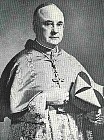
(16) 16. SPELLMAN, Francis Joseph
(1889-1967)
Birth. May 4, 1889, Whitman, archdiocese of Boston, United States. He was the eldest of the five children of William Spellman, who owned a grocery, and Ellen Conway.
Education. Studied at Fordham College, New York; and at the Pontifical Urbanian Athenaeum "De Propaganda Fide," Rome.
Priesthood. Ordained, May 14, 1916, Rome, by Giuseppe Cappetelli, titular patriarch of Constantinople, vice gerent of Rome. Pastoral ministry in the archdiocese of Boston, 1916-1918; 1932-1939. Vice-chancellor of the archdiocese of Boston, 1918-1922. Editor of The Boston Pilot, 1924-1935. Attaché in the Secretariat of State, 1925-1932. Privy chamberlain of His Holiness, October 4, 1926.
Episcopate. Elected titular bishop of Sila and appointed auxiliary of Boston, July 30, 1932. Consecrated, September 8, 1932, patriarchal Vatican basilica, by Cardinal Eugenio Pacelli, secretary of State, assisted by Giuseppe Pizzardo, titular archbishop of Nicea, secretary of the S.C. of Extraordinary Ecclesiastical Affairs, and by Francesco Borgongini-Duca, titular archbishop of Eraclea di Europa, nuncio to Italy. His episcopal motto was Sequere Deum. Promoted to the metropolitan see of New York, April 15, 1939. Named, in addition, military vicar of United States Armed Forces, December 11, 1939.
Cardinalate. Created cardinal priest in the consistory of February 18, 1946; received the red hat and the title of Ss. Giovanni e Paolo, February 22, 1946. Papal legate to the National Eucharistic Congress, Manila, Philippines, November 1, 1956. Ordinary of the newly erected ordinariate of the armed forces, September 8, 1957. Participated in the conclave of 1958, which elected Pope John XXIII. Papal legate to the Central American Eucharistic Congress, Guatemala, January 29, 1959. Attended the Second Vatican Council, 1962-1965; member of its board of presidency, 1962-1965. Participated in the conclave of 1963, which elected Pope Paul VI.
Death. December 2, 1967, New York. Although he once expressed his wish to have the funeral of a simple priest, he was laid out in state for five days in St. Patrick's metropolitan cathedral. Hundreds of thousands of New Yorkers filed past the catafalque in tribute. The funeral Mass was concelebrated by nine cardinals, two archbishops, seven bishops and one priest, the late cardinal's nephew, the Rev. John J. Pegnam, a Navy chaplain who had been on a ship stationed off South Viet Nam. President Lyndon B. Johnson; Vice President Hubert Humphrey; Senators Robert Kennedy and Jacob Javits, both of New York, Governor Nelson Rockefeller of New York, Mayor John Lindsay of New York; Arthur Goldberg, U.S. ambassador to the United Nations; and more than one hundred Catholic bishops and almost fifty Protestant, Orthodox and Jewish clerics were present at the cathedral. Among them was Archbishop Iakovos, Orthodox Primate of North and South America, who was invited to sit on an elevated, canopied throne in the sanctuary. It was the first time that an Orthodox prelate had been so honored in New York. The body of the cardinal was buried in the crypt of that metropolitan cathedral (1).
Bibliography. Cooney, John. The American pope. The life and times of Francis Cardinal Spellman. New York : Times Books, 1984. Gannon, Robert I. The Cardinal Spellman story. London : R. Hale, 1962; Steibel, Warren. Cardinal Spellman. The man. With an Introduction by Francis Cardinal Spellman. New York : Appleton-Century, 1966.
Webgraphy. Photographs, portrait and arms, Araldica Vaticana; New York Archdiocese Responds to Cardinal Spellman Groping Allegation by Kevin Jones, National Catholic Register, CNA, New York City, Feb. 12, 2019.
(1) This is the inscription in his tomb, kindly provided by Mr. Eman Bonnici, from Malta:
FRANCIS CARDINAL SPELLMAN ARCHBISHOP MILITARY VICAR 1939 - 1967
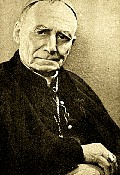
(17) 17. CARO RODRÍGUEZ, José María
(1866-1958)
Birth. June 23, 1866, in Los Valles, a town located in the Hacienda San Antonio de Petrel, present commune of Pichilemu and former province of Colchagua, diocese of Roncagua, Chile. Fourth of the nine children of José María Caro Martínez, who was the first mayor of Pichilemu, and Rita Rodríguez Cornejo.
Education. Initial studies in the local school; Seminary of Santiago, Santiago de Chile, 1881-1886 (humanities); Pontifical Collegio Pio-Latinoamericano, Rome; Pontifical Gregorian University, Rome, 1887-1891 (theology; among his professors was Father Louis Billot, S.J., future cardinal).
Priesthood. Ordained, December 20, 1890, Rome. Returned to Chile on October 2, 1891. From 1892 to 1899, professor of preparatory studies and philosophy at the Seminary of Santiago; pastoral ministry in several chaplaincies, hospitals and parishes; pastor of Mamiña, March to December 1899; professor of theology at the Seminary of Santiago, 1900-1911; always had a very delicate health. Named apostolic vicar of Tarapac on May 6, 1911.
Episcopate. Elected titular bishop of Milasa, January 5, 1912, Consecrated, April 28, 1912, metropolitan cathedral of Santiago, by Enrico Sibilia, titular archbishop of Side, internuncio in Chile, assisted by Luis Izquierdo Vargas, bishop of Concepción, and by Miguel Claro Vázquez, titular bishop of Legia. His episcopal motto was Virtus nostrum et Deo refugium. Transferred to the see of La Serena, December 14, 1925. Assistant at the Pontifical Throne, November 6, 1937. Promoted to archbishop when La Serena was elevated to the rank of metropolitan see, May 20, 1939. Transferred to the metropolitan see of Santiago, August 28, 1939. Grand chancellor of the Catholic Universoty of Chile from 1939 until 1958.
Cardinalate. Created cardinal priest in the consistory of February 18, 1946; received the red hat and the title of S. Maria della Scala, deaconry elevated pro illa vice to title, May 18, 1946. Papal legate to the Chilean Plenary Council, Santiago, September 8, 1946; to the 10th National Eucharistic Congress, Valparaíso, Chile, September 26, 1951. Attended the First General Conference of the Latin American Episcopate, Rio de Janeiro, Brazil, July 25 to August 4, 1955. Papal legate to the Sixth Interamerican Congress of Catholic Education, Santiago de Chile, Chile, August 30, 1956. Participated in the conclave of 1958, which elected Pope John XXIII. He was the first Chilean cardinal.
Death. December 4, 1958, at 1:20 p.m., from an attack of toxic gastroenteritis followed by symptoms of uremia and pneumonia which ultimately led to his death, in Santiago de Chile. Originally buried in the crypt of the archbishops in the metropolitan cathedral of Santiago de Chile, his remains were transferred to a sarcophagus donated by the Hogar de Cristo institution, to the back of the cathedral's central nave on March 19, 1968 (1), where they remained until April 2006 when they were transferred anew to the Nueva Cripta Arzobispal where he was reinterred alongside Cardinals Raúl Silva Henríquez S.D.B., Francisco Fresno Larraín, Carlos Oviedo Cavada, O. de M., and Jorge Arturo Medina Estévez.
Bibliography. Caro Rodríguez, José María. Autobiografía del eminentísimo y reverendísimo señor cardenal D. José María Caro Rodríguez, primer cardenal chileno. Apuntes y recuerdos por Joaquín Fuenzalida Morandé. Documentos importantes. Santiago: Arzobispado de Santiago, 1968; Vanherk Moris, Juan. Monseñor José María Caro, apóstol de Tarapac. Santiago de Chile : Editorial del Pacífico, 1963. Salinas Fuenzalida, Augusto. Un pastor santo, el emintentísimo señor cardenal don José María Caro Rodríguez, 1866-1958. Santiago de Chile: Editorial Andrés Bello, 1981.
Webgraphy. His photograph, statue, tomb, arms and biography, in Spanish, Wikipedia; his photograph and biography, in Spanish, archdiocese of Santiago de Chile; photographs and arms, Araldica Vaticana.
(1) The sarcophagus which contains his remains was donated by the members of the Hogar de Cristo, founded by Saint Alberto Hurtado, as a sign of affection towards Cardinal Caro’s vicinity to their foundation. Its simple inscription, kindly provided by Mr. Eman Bonnici, from Malta, reads:
JOSE MARIA CARDENAL CARO RODRIGUEZ 1866 ﹣ 1958
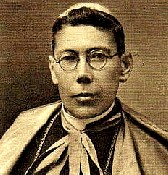
(18) 18. GOUVEIA, Teodósio Clemente de
(1889-1962)
Birth. May 13, 1889, at 8 a.m., São Jorge, Madeira, diocese of Funchal, Portuguese Africa. Son of Clemente Francisco de Gouveia and Ana Augusta Jardim, farmers. He was baptized on May 25, 1889, in the parish church of São Jorge, by Vicar José Calisto de Andrade; his godparents were Teodósio Francisco de Gouveia and Maria Rosa Jardim.
Education. Primary education in São Jorge; Seminary "Nossa Senhora da Encarnaçao", Funchal, October 4, 1905; the seminary was confiscated in October 1910 by the revolution; Claretians priests, directors of the seminary, took the students to the house of studies of the congregation in Paris 1912-1913; later, because of the German invasion they went to the Lazarist Seminary, Dax, France, 1914-1915 (philosophy and theology); joined the order in 1911; Seminary of Saint Sulpice, Paris; Institut Catholique, Paris (philosophy); left the order in 1915 and arrived in Rome on January 7, 1916; Pontifical Gregorian University, Rome, 1916-1919 (doctorates in theology and canon law); resided in the Colégio Português, Rome; School of Social Studies, Bergamo, 1920-1921 (licentiate in social sciences); University of Louvain, Louvain, 1921-1922 (licentiate in social sciences); returned to Madeira in 1922. Received the last two minor orders, exorcist and acolyte, May 12, 1918; the subdiaconate, November 1, 1918; and the diaconate, December 21, 1918, church of S. Andrea della Valle, Rome.
Priesthood. Ordained, Holy Saturday April 19, 1919, patriarchal Lateran basilica, by Cardinal Basilio Pompilj, vicar of Rome and archpriest of the patriarchal Lateran basilica; celebrated his first Mass on Easter Sunday April 20, 1919 in the patriarchal Vatican basilica. Secretary of the ecclesiastical chamber of the diocese of Funchal and faculty member of its seminary; director of Boletim Diocesano da Madeira, 1922-1929. Vice-rector of the Pontifical Portuguese College, Rome, March 1929-1934; rector, March 1934-1936. Rector of the church of S. Antonio dei Portughesi, Rome, 1931-1936. Privy chamberlain of His Holiness, November 26, 1931. Domestic prelate of His Holiness, April 23, 1934.
Episcopate. Elected titular bishop of Leuce and appointed prelate nullius of Moçambique, Portuguese Africa, May 18, 1936. Consecrated, July 9, 1936, church of S. Antonio dei Portughesi, Rome, by Cardinal Raffaele Carlo Rossi, O.C.D., secretary of S.C. Consistorial, assisted by Ernesto Senna de Oliveira, titular archbishop of Mitilene, auxiliary of Lisbon, president of the Central Board of the Portuguese Catholic Action, and by Ildebrando Antoniutti, titular archbishop of Sinnada de Frigia, apostolic delegate to Albania. His episcopal motto was Omnibus omnia facto. Decorated with the grand cross of the Ordem da Cristo, 1939. Promoted to the newly erected archdiocese of Lourenço Marques (now Maputo), Moçambique, January 18, 1941.
Cardinalate. Created cardinal priest in the consistory of February 18, 1946; received the red hat and the title of S. Pietro in Vincoli, February 22, 1946. Participated in the conclave of 1958, which elected Pope John XXIII. Decorated with the grand cross of the Ordem do Infante D. Henrique, 1961. He was the first cardinal from Moçambique.
Death. February 6, 1962, at 3:45 p.m., of leukemia, in São Vicente archiepiscopal palace, Lourenço Marques. He was exposed in the palace until the following day at 5 p.m., when the body was transferred to the metropolitan cathedral of "Nossa Senhora da Conceição"; the funeral took place on February 8, 1962 at 10 a.m., in that cathedral, where he was buried, behind the main altar, in a plain tomb marked only with his arms, according to his will.
Bibliography. Veloso, Agostinho. D. Teodósio Clemente de Gouveia; paladino do Portugal ao serviço de Deus. 2 vols. Lisbon : Agencia-Geral do Ultramar, 1965.
Webgraphy. Photographs and arms, Araldica Vaticana.

(19) 19. CÂMARA, Jaime de Barros
(1894-1971)
Birth. July 3, 1894, São José, archdiocese of Florianópolis, Brazil. Son of Joaquim Xavier de Oliveira Cãmara, registrar of orphans, and his second wife, Anna de Carvalho Barros.
Education. Studied at the Seminary of São Leopoldo, Rio Grande do Sul.
Priesthood. Ordained, January 1, 1920, Florianópolis, by Joaquim Domingues de Oliveira, archbishop of Florianópolis. Pastoral ministry in the archdiocese of Florianópolis, 1920-1935, first as substitute of the pastor of the cathedral of Florianópolis; later, as coadjutor of the parish of Tijucas and chaplain of the Sisters of the Divine Providence; and finally, as pastor of the metropolitan cathedral. Rector of the Seminary Azambuja-Brusque, Florianópolis, 1935-1936. Privy chamberlain of His Holiness, April 18, 1935.
Episcopate. Elected first bishop of Mossoró, December 19, 1935. Consecrated, February 2, 1936, Florianópolis, by Joaquim Domingues de Oliveira, archbishop of Florianópolis, assisted by Pio de Freitas Silveira, C.M., bishop of Joinville, and by Daniel Henrique Hostin, O.F.M., bishop of Lages. His episcopal motto was Ignem veni mittere. Took possession of the see the following April 26. During his episcopate, he founded the Seminary of Mossoró and a home for the elderly; celebrated a Eucharistic Congress in Areia Branca; and paid special attention to the instruction of the workers and to the factories where anti-Christian and demagogic ideas were proliferating. Promoted to metropolitan see of Belém do Pará, September 15, 1941. Took possession of the archdiocese on January 1, 1942. In his new see, he dedicated special attention to the plight of the workers. Transferred to the metropolitan see of São Sebastião do Rio de Janeiro, July 3, 1943. He took possession of the see the following September 12.
Cardinalate. Created cardinal priest in the consistory of February 18, 1946; received the red hat and the title of Ss. Bonifacio ed Alessio, February 22, 1946. Papal legate to the National Eucharistic Congress, Porto Alegre, October 3, 1948; and also, to the Interamerican Congress of the Confederation of Catholic Education, Rio de Janeiro, July 4, 1951. Convoked and presided over the first archdiocesan synod in 1949, which decisions were published on January 1, 1950. Named by the Holy See, took possession as military vicar of Brazil on January 22, 1951, in the presence of the president of the Republic and the entire cabinet. Attended the First General Conference of the Latin American Episcopate, Rio de Janeiro, July 25 to August 4, 1955. President of the Conference of Catholic Bishops of Brazil, 1958-1963. Participated in the conclave of 1958, which elected Pope John XXIII. Papal legate to the National Eucharistic Congress, Curitiba, March 5, 1960. Attended the Second Vatican Council, 1962-1965. Participated in the conclave of 1963, which elected Pope Paul VI. During his episcopate, he founded the Ação Social Arquidiocesana for the spiritual and social needs of the population of Rio de Janeiro; rebuilt the Seminary of São José in Rio Comprido; founded numerous parishes; established the Comissão Arquidiocesana de Música Sacra and the Sociedad Brasileira de Arte Cristã; as well as the publication A Província Eclesiástica do Rio de Janeiro; and promoted the circulation of the daily Correio da Noite.
Death. February 18, 1971, suddenly of pulmonary edema at Palácio Paulino in Aparecida, while attending celebrations commemorating the first Mass celebrated in Brazil on the day of the twenty fifth anniversary of his elevation to the Sacred College of Cardinals. The funeral Mass, presided by Cardinal Eugénio de Araújo Sales, was celebrated on the following day, February 19, at the then metropolitan cathedral do Rio de Janeiro (nowadays parish church of Nossa Senhora do Carmo da Antiga Sé) followed by burial in the crypt of the new metropolitan cathedral of São Sebastião do Rio de Janeiro (1). A bust commemorating him was erected in the Praça da Igreja Matriz de São José, Santa Catarina.
Bibliography. Calliari, Ivo. D. Jaime Cãmara: diário do Cardeal Arcebispo do Rio de Janeiro. Rio de Janeiro: Léo Christiano Editorial, 1996; "Jaime de Barros Câmara" in "Terceira parte, Bispos do Brasil-Republica, Os cinco primeiros cardeais" in "Diocesis e bispos do Brasil" by Apolônio Nóbrega, Revista do Instituto Histórico e Geográfico Brasileiro, volume 222, Janeiro-Março 1954, 197-199.
Webgraphy. His arms, photograph and biography, in Portuguese, Wikipedia; his arms and photographs, Araldica Vaticana; 50 anni fa la morte del Cardinale brasiliano Camara by Marco Mancini, ACI Stampa, Rio de Janiero, 18 febbraio, 2021.
(1) This is the text of the inscription on his vault, kindly provided by Mr. Eman Bonnici, from Malta:
* 03-07-1894 † 18-02-1971 DOM JAIME DE BARROS CȂMARA 4° ARCEBISPO DO RIO DE JANEIRO DE 03-07-1943 A 18-02-1971 AQUÍ ESPERA A RESSUREIÇÃO

(20) 20. PLA Y DENIEL, Enrique
(1876-1968)
Birth. December 19, 1876, Barcelona, Spain. Of a high middle class family. His parents were Narciso Pla Masgrau and Emilia Deniel.
Education. Institute of Barcelona, Barcelona, for a short period; Seminary of Barcelona, Barcelona (first year of Latin only); went to Rome with Manuel Domingo y Sol, future blessed; resided at Pontificio Colegio Español, Rome; Pontifical Roman Academy of S. Tommaso d'Aquino, Rome; Pontifical Gregorian University, Rome, 1892-1903 (doctorates in philosophy, theology and canon law).
Priesthood. Ordained, July 25, 1900, Rome. Further studies, 1900-1903. Pastoral ministry in the diocese of Barcelona; faculty member of the Seminary of Barcelona; director of El Social, Revista Social, and Revista Eclesiástica; and canon of the cathedral chapter, 1903-1918.
Episcopate. Elected bishop of Avila, December 4, 1918. Consecrated, June 8, 1919, cathedral of Barcelona, by Francesco Ragonesi, titular archbishop of Mira, nuncio to Spain, assisted by Enrique Reig y Casanova, bishop of Barcelona, and by Francisco de Paula Mas y Oliver, bishop of Gerona. His episcopal motto was Fiat voluntas tuas. Transferred to see of Salamanca, January 28, 1935. Strongly supported National Movement of Generalissimo Francisco Franco in the Spanish Civil War. Promoted to the metropolitan and primatial see of Toledo, October 3, 1941.
Cardinalate. Created cardinal priest, February 18, 1946; received the red hat and the title of S. Pietro in Montorio, February 22, 1946. Papal legate to the celebrations in honor of Saint James the Apostle, Compostela, Spain, July 25, 1948; to the National Marian Congress, Zaragoza, Spain, September 24, 1954. Participated in the conclave of 1958, which elected Pope John XXIII. Attended the Second Vatican Council, 1962-1965; member of the board of presidency, 1962-1965. Participated in the conclave of 1963, which elected Pope Paul VI.
Death. July 5, 1968, of a cerebral embolism, in Toledo (1). Buried in the metropolitan and primatial cathedral of Toledo, on the Epistle side of the altar in the Capilla del Sagrario (2).
Bibliography. Alfonso Sánchez, José Manuel. Iglesia, política y educación en España, (1940-1960) : documentos del Archivo Pla y Deniel. Madrid : Fundación Universitaria Española, 2005-. (Publicaciones de la Fundación Universitaria Española.; Monografías ; 99). Contents: t. 1. Orientación católica de la enseñanza; Alfonso Sánchez, José Manuel. Correspondencia entre Pla y Deniel, Ruiz-Giménez y Olaechea (1951-1953) : el conflicto político y eclesial ante la reforma de la enseñanza media. Salamanca : Universidad Pontificia de Salamanca, 2004. (Estudios de la Facultad de CC. de la educación ; 1); Echeverría, Lamberto de. Episcopologio español contemporáneo, 1868-1985 : datos biográficos y genealogía espiritual de los 585 obispos nacidos o consagrados en España entre el 1 de enero de 1868 y el 31 de diciembre de 1985 . Salamanca : Universidad de Salamanca, 1986. (Acta Salmanticensia; Derecho; 45), p. 81; "Ha muerto el cardenal primado," Ecclesia, July 13, 1968, pp. 16-18; Morán Sánchez-Cabezudo, Benjamín. El cardenal primado de España y el origen del poder. Madrid : Studium, 1963. (Colección Scientia).
Webgraphy. Biography by Vicente Cárcel Ortí, Diccionario Biográfico Español, DB~e; photographs and arms, Araldica Vaticana.
(1) This is the text of his spiritual testament, taken from "Ha muerto el cardenal primado," Ecclesia, July 13, 1968, p. 17:
"Siendo cierta la muerte de todo hombre, y sólo inciertos el modo y momento, y disponiendo el ceremonial de los obispos que éstos, en vida y en muerte, adoctrinen con su ejemplo y con su palabra a los fieles que tienen encomendados; no sabiendo si estaré en estado de poder en la hora de mi muerte hacer mi última exhortación pastoral a mis amadísimos sacerdotes y fieles toledanos, la escribo en estos días en que me hallo retirado practicando ejercicios espirituales en compañía de otros hermanos en el Episcopado.
Carísimos sacerdotes a quienes consagré ministros del Señor o a quienes consagrados ya por alguno de mis antecesoras, me tocó presidir como obispo: recordad siempre que fuisteis ordenados sacerdotes para estar al servicio de Dios y de las almas; para ello necesitáis conservar siempre vuestra vida interior y aun ir creciendo en ella; debéis dar ejemplo de santidad a los fieles con vuestra vida inmaculada, con vuestro desinterés, con vuestro espíritu de caridad y de abnegado y ardiente celo por la salvación de las almas.
Carísimos fieles: procurad ante todo la salvación de vuestras almas, que para esto os ha puesto Dios en este mundo, en una vida temporal, muy breve siempre comparada con la vida eterna. No dejéis el cumplimiento de vuestros deberes religiosos, pues sin él no seréis reconocidos como verdaderas cristianos en el día del juicio.
Mujeres: no seáis con vuestra inmodestia responsables del los pecados de los hombres.
Padres de familia: cuddad de la cristiana educación y vigilancia de vuestros hijos. Los que tenéis riquezas no olvidéis los deberes de caridad que ellas imponen.
Patronos y empresarios: no os hagáis responsables de injusticias no dando salarios suficientes a vuestros obreres o poniendo precios excesivos a vuestras mercancías.
Obreros: no os despojéis de vuestra gran dignidad de hijos de Dios, ante el cual gozáis de plena igualdad con los que ante los hombres temporalmente os aventajan, seducidos por la fantástica igualdad que predica el comunismo, convertida, si triunfa. en despótica tiranía que atropella la dignidad de la persona humana.
Estos son los últimos consejos de quien ha sido padre de vuestras almas y que ahora os pide una oración por la suya.
En Los Negrales, a 3 de julio de 1961. Enrique, Cardenal Pla y Deniel, arzobispo de Toledo."
(2) This is the text of his Rogito, kindly provided by Mr. Mark West, from London:
HENRICUS CARD. PLA Y DENIEL NATUS BARCHINONAE (19-XII-1876), EPISCOPUS ABULEN DEINDE SALMANTIN., DEMUM ARCHIEPISCOPUS TOLETAN HISPANIARUM PRIMAS (1942-1968), CARD.TIT. SANCTI PETRI IN MONTORIO, INTERFUIT ELECTIONIBUS JOHANNIS PAPAE XXIII ET PAULI VI, PATER CONCILIAR. IN CONC. VAT. II. CONFERENTIAE METROPOLITANORUM HISPANIAE PRAEFUIT, IN MAGNA STRAGE BELLI UNIVERSALIS ET HISPANIAE POST BELLUM CIVILE LANGUORE FIRMUS ANIMORUM SUSTENTATOR. PONTIFICIAM UNIVER. SALMANTIN. RESTAURAVIT, ACTIONEM CATHOLICAM ET SOCIALEM LAICORUM STRENUE PROPUGNAVIT. IURIS SERVATOR, ECCLESIAE DEVOTUS MINISTER, GRAVIS, MUNIFICUS, PIUS ET PAUPER OBDORMIVIT IN DOMINO TOLETI (5-VII-1968). IACET SEPULTUS IN CAPELLA SANCTAE MARIAE VIRGINIS SACRARIO IN ECCLESIA CATHED. TOLETAN
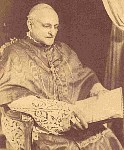
(21) 21. ARTEAGA Y BETANCOURT, Manuel
(1879-1963)
Birth. December 28, 1879, Puerto Príncipe (now Camagüey), archdiocese of Santiago de Cuba, Cuba. Son of Rosendo Arteaga Montejo and Delia Betancourt Guerra. Baptized on April 17, 1880, at the principal parish church of Puerto Príncipe, by Father Virgilio Arteaga; he received the names Manuel Francisco del Corazón de Jesús. Received the sacrament of confirmation on November 17, 1882, in Puerto Príncipe, from José Martín de Herrera y de la Iglesia, archbishop of Santiago de Cuba. His paternal uncle, Father Ricardo Arteaga Montejo, who had left Cuba for Venezuela for political reasons, took the future cardinal to that country in 1892.
Education. Studied at the Central University of Venezuela, obtaining a bachelor in philosophy on June 15, 1898; entered the Capuchin convent in Caracas in 1900; for health reasons had to leave the convent and entered the Seminary of Santa Rosa de Lima, Caracas, on April 12, 1901; received the clerical tonsure and the four minor orders on August 10, 1902; the subdiaconate on November 10, 1902; and the diaconate on December 7, 1902.
Priesthood. Ordained, April 17, 1904, Caracas, by Juan Bautista Castro, archbishop of Caracas. Pastoral ministry, Cumaná, Venezuela, 1906-1912; Camagüey, Cuba, 1912-1915. Provisor and vicar general of the diocese of San Cristóbal de La Habana, 1915-1941; canon schoolmaster, 1916. Domestic prelate of His Holiness, May 31, 1926. Vicar capitular of the archdiocese of San Cristó;bal de La Habana, January 3, 1940.
Episcopate. Elected archbishop of San Cristóbal de La Habana, December 26, 1941. Consecrated, February 24, 1942, cathedral of San Cristóbal de La Habana, by Giorgio Caruana, titular archbishop of Sebaste, apostolic nuncio to Cuba, assisted by Valentón Zubizarreta Unamunzaga, O.C.D., archbishop of Santiago de Cuba, and by Eduardo Martínez Dalmau, C.P., bishop of Cienfuegos. His episcopal motto was Tu adjutor fortis.
Cardinalate. Created cardinal priest in the consistory of February 18, 1946; received the red hat and the title of S. Lorenzo in Lucina, February 28, 1946. Papal legate to the First National Eucharistic Congress, La Habana, January 10, 1946; to the coronation of Our Lady of Coromoto, Venezuela, July 30, 1952. Participated in the Fifth Interamerican Congress of Catholic Education, Colegio de Belén, La Habana, Cuba, December 1954 (1). Attended the First General Conference of the Latin American Episcopate, Rio de Janeiro, Brazil, July 25 to August 4, 1955. Participated in the conclave of 1958, which elected Pope John XXIII. Persecuted by Communist regime of Fidel Castro, sought asylum in the Argentinean Embassy; in the apostolic nunciature, 1961-1962; and later, in "San Juan de Dios" Hospital, 1962-1963, where he died. He was the first Cuban cardinal.
Death. March 20, 1963, of pneumonia which he contracted two weeks prior to his death after a long history of failing health mainly due to arteriosclerosis at Hospital San Juan de Dios, La Habana. Exposed in the metropolitan cathedral of San Cristóbal de La Habana. Buried in "Cristóbal Colón Cemetery", La Habana, in a tomb that he had built several years earlier (2).
Bibliography. Céspedes García Menocal, Carlos Manuel de. Imagen luminosa de un hombre cuestionado. Intento de aproximación a la persona del Eminentísimo Señor Cardenal Manuel Arteaga y Betancourt, Arzobispo de La Habana. La Habana, 20 de agosto de 1996 (unpublished); Gaínza González, Fernando. El Cardenal Arteaga. Havana: Editorial Lex, 1949. Del Valle, Raúl. El Cardenal Arteaga: Resplandores de la púrpura cubana. Havana: Impresos Ramallo, 1954.
Webgraphy. Biography by Salvador Miranda, in Spanish, Episcopologio de la Iglesia Católica en Cuba; his photographs, portrait and arms, Araldica Vaticana.
(1) At the end of the congress, on December 1, 1954, Pope Pius XII delivered a radio message in which he had prophetic words concerning the future of Cuba.
(2) This is the inscription in his tomb, kindly provided by Mr. Eman Bonnici from Malta:
MANUEL, CARDENAL ARTEAGA Y BETANCOURT PULVIS ES 1879 - 1963
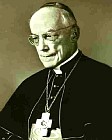
(22) 22. FRINGS, Joseph
(1887-1978)
Birth. February 6, 1887, in the small city of Neuss, archdiocese of Köln, Germany. Second of the eight children of Heinrich Frings, a weaving mill manufacturer and a city councillor, and Maria Sels. His baptismal name was Joseph Richard. Very early he discovered that he had a vocation to the priesthood. The house of his family was destroyed by a bomb during the Second World War.
Education. Initially, he frequented the gymnasium of Neus; then he studied at the University of Innsbruck; later at the University of Bonn (theology); from 1913 until 1915, at the Pontifical Biblical Institute, Rome; while in Rome, he resided in Collegio Germanico di Santa Maria dell'Anima; and finally at the University of Freiburg, where he obtained a doctorate in theology in 1916.
Priesthood. Ordained, August 10, 1910, Köln, by Cardinal Anton Hubert Fischer, archbishop of Köln. Four days later, he sang his first Mass in his home town. Chaplain in Köln-Zollstock, 1910-1913. Further studies in Rome, 1913-1915. Pastor in Köln-Fühlingen, 1915-1922. Director of an orphanage in Neuss, 1922-1924. Named pastor in Köln-Braunsfeld on April 2, 1924; remained in the post until 1937. Named rector of the Seminary of Köln on March 4, 1937; occupied the post until his promotion to the episcopate in 1942.
Episcopate. Elected archbishop of Köln, May 1, 1942. Consecrated, June 21, 1942, metropolitan cathedral of Köln, by Cesare Orsenigo, titular archbishop of Tolemaide di Libia, nuncio to Germany, assisted by Joseph Hammels, titular bishop of Soli, auxiliary of Köln, and by Wilhelm Stockums, titular bishop of Eritre, auxiliary of Köln. His episcopal motto was Pro hominibus constitutus. Soon afterward, he issued a pastoral letter, "Justice and Law", protesting against those in power who flouted law; against the race struggle; and against the persecution of the Jews. Chairman of the Fulda Conference of Catholic Bishops (1), 1945-1965. After the end of the Second World War, he went to Canada, the United States of American and Great Britain asking for help to end the German misery. He celebrated a diocesan synod in 1954 with three hundred delegates of the Köln clergy participating. By 1955, through his efforts, 724 churches had been rebuilt; 163 had been totally renovated; 59 new ones had been built; and he built the Marian College, for priestly formation, in Neuss. He was the honorary chairman of the Association of Catholic Merchants Societies in Germany.
Cardinalate. Created cardinal priest in the consistory of February 18, 1946; received the red hat and the title of S. Giovanni a Porta Latina, February 22, 1946. Participated in the conclave of 1958, which elected Pope John XXIII. Attended the Second Vatican Council, 1962-1965; member of the Board of Presidency, 1962-1965. Participated in the conclave of 1963, which elected Pope Paul VI. Resigned the pastoral government of the archdiocese of Köln, February 10, 1969. Lost his right to participate in the conclave by being older than eighty years of age, January 1, 1971. Cardinal protoprete, October 21, 1977. By the end of his life he had lost most of his eyesight. He was closely linked to Adveniat and Misereor, the two great relief societies of German Catholics in the underdeveloped countries. He played the violin well and liked both classical and modern music. His favorite author was William Shakespeare.
Death. December 17, 1978, of a heart attack, in Köln. Buried in the metropolitan cathedral of Köln.
Bibliography. Dahm, Paul. Joseph Cardinal Frings. Notre Dame, Ind. : University of Notre Dame Press, 1964. (The Men who make the Council, 10); Frings, Joseph. Für die Menschen bestellt : Erinnerungen des Alterzbischofs von Köln Josef Kardinal Frings. Köln : Bachem, 1973; Frings, Josef ; Froitzheim, Dieter. Kardinal Frings : Leben u. Werk. Köln : Wienand, 1979. Responsibility: Dieter Froitzheim, Herausgeber; Hegel, Eduuard. "Frings, Joseph." Die Bischöfe der deutschsprachigen Länder, 1785/1803 bis 1945 : ein biographisches Lexikon. Herausgegeben von Erwin Gatz. Berlin : Duncker & Humblot, 1983, pp. 210-213; Ruf, Friedhelm. Der rheinische Kardinal. Josef Frings, seelsorger, diplomat und brückenbauer. Köln : J. P. Bachem Verlag, 2015; Sikora, Joachim ; Nitsche, Hans. Josef Kardinal Frings : Honnefer Akzente. Bad Honnef : Katholisch-Soziales Institut der Erzdivzese Kvln, 1996. Note: "Schriften von und über Kardinal Frings": Responsibility: Joachim Sikora, Hans Nitsche (Hg.) ; herausgegeben aus Anlass der Wiederervffnung des Kardinal-Frings-Hauses am 1. September 1996, mit Bildern und Skizzen von Ernst Günter Hansing; Trippen, Norbert. Josef Kardinal Frings (1887-1978). 2 vols. Paderborn : Ferdinand Schöningh, 2003-2005. (Veröffentlichungen der Kommission für Zeitgeschichte ; Reihe B ; Forschungen ; Bd. 94; 104).
Webgraphy. His tomb, metropolitan cathedral of Cologne; his arms, Araldica Vaticana.
(1) The conference was established by the German bishops meeting in 1848 in the episcopal city of Fulda at the grave of Saint Bonifacius, the patron saint of Germany. After the Second Vatican Council (1962-1965), the German Catholic bishops established the German Conference of Bishops in 1966.
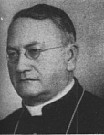
(23) 23. GUEVARA, Juan Gualberto
(1882-1954)
Birth. July 12, 1882, Villa de Vitor, diocese of Arequipa (archdiocese since 1943), Perú. Son of Simón Guevara and Eulogia Cuba.
Education. Studied at the Seminary of San Jerónimo, Arequipa; received the minor orders, the subdiaconate and the diaconate from Bishop Manuel Segundo Ballón of Arequipa; he also studied at the University of San Agustín, Arequipa, where he entered in 1912 and obtained a bachelor's in letters; and at the Pontifical Gregorian University, Rome, where he earned a doctorate in canon law in 1922.
Priesthood. Ordained, June 2, 1906, Arequipa, by Bishop Ismael Puirredón of Arequipa. Pastoral ministry in Arica, 1906-1910; vice pastor and chaplain of Yura; expelled by Chile when it claimed the province of Arica. Vice-rector of the Seminary of Arequipa, 1914-1920. Further studies, 1910-1912. Staff member of El Deber, oldest newspaper in southern Perú, 1916-1940; its director, 1928-1940. Sacristan of the cathedral of Arequipa, 1916-1920. Domestic prelate of His Holiness, June 10, 1936.
Episcopate. Elected bishop of Trujillo, Perú, December 15, 1940. Consecrated, March 2, 1941, Arequipa, by Fernando Cento, titular archbishop of Seleucia Pieria, nuncio to Perú, assisted by Felipe Santiago Hermosa y Sarmiento, bishop of Cuzco, and by Domingo Juan Vargas, O.P., titular bishop of Gerara, former bishop of Huaraz. His episcopal motto was Dominus illuminatio mea. Promoted to archbishop when Trujillo was elevated to metropolitan see, May 23, 1943. During his episcopate in Trujillo, he carried out an exhaustive visitation of his extensive jurisdiction up to Pataz; the separation of the school of externs from the seminary; the celebration of the Third National Eucharistic Congress, on October 27-31, 1943; and the canonical coronation of Our Lady of the Gate of Otuzco in 1944. Named military vicar of Perú on January 13, 1945. Transferred to the metropolitan and primatial see of Lima on December 16, 1945. Took possession of the see through a delegate on January 11, 1946 because he had to leave for Rome to receive the red hat.
Cardinalate. Created cardinal priest in the consistory of February 18, 1946; received the red hat, February 21, 1946; and the title of S. Eusebio, February 28, 1946. Papal legate to the National Eucharistic Congress, Sucre, Bolivia, June 16, 1946. He died while the 5th National Eucharistic and Marian Congress was being celebrated in Lima. He was the first Peruvian cardinal.
Death. November 27, 1954, of a heart attack after a long battle with cancer, in Lima, on the eve of celebrating the Fifth National Eucharistic and Marian Congress of Perú, which he had diligently prepared and organized. Buried in the metropolitan cathedral of Lima (1).
Webgraphy. His portrait and biography, in Spanish, Wikipedia; chronography, in English, Catholic Hierarchy; his photograph, portrait and arms, Araldica Vaticana; catalog of the archbishops of Lima, in Spanish, Wikipedia.
(1) This is the text of the inscription on his tomb, kindly provided by Mr. Eman Bonnici, from Malta:
HIC JACET JOANNES GUALBERTUS GUEVARA, ARCHIEPISCOPUS LIMAE, PRIMAS PERUVIAE QUI ORNATUS PURPURA CARDENALITIA, PRIMUS FUIT. INGENIO, VIRTUTE, PRAESTANS, SCRIPTIS, ROBORE, APOSTOLICO ZELO ATQUE. CARITATE IN ECCLESIA PRAEFULSIT. OMNIA BENE FECIT SEMPER IN MENTE HABENS MAJOREM DEI LAUDEM ANIMARUMQUE SALUTEM. OBDORMIVIT IN DOMINO DIE 26 NOVEMBRIS 1954 REQUIESCAT IN CHRISTI PACE!
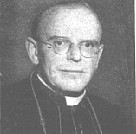
(24) 24. GRIFFIN, Bernard William
(1899-1956)
Birth. February 21, 1899, Oakfiled Road, Cannon Hill, Birmingham, England. He was the twin son of William Griffin, a cycle manufacturer's manager and city councillor, and his wife, Helen Swadkins; they had five children; his younger twin brother, Walter Basil, became a Benedictine at the Douai abbey community; and one of his three sisters joined the Sisters of Mercy.
Education. Studied at King Edward's Grammar School, Birmingham; at Cotton College, a junior seminary, Staffordshire, from 1913 to 1917; together with his twin brother Walter Basil, he joined the ranks of the Royal Naval Air Service from 1917 until 1918, he spent the final year of the First World War; at Oscott College, Birmingham, from 1919 to 1922; at the Venerable English College, Rome, 1922, where the rector was Monsignor Arthur Hinsley, future cardinal; at the Pontifical Urbanian Athenaeum "De Propaganda Fide", Rome, where he obtained a doctorate in theology in 1924; and at the Venerable Beda College, Rome, where he earned a doctorate in canon law in 1927.
Priesthood. Ordained, November 1, 1924, Rome. Further studies, Rome, 1924-1927. Secretary to the archbishops of Birmingham, John McIntyre and Thomas Williams, 1927-1937. Parish priest of Coleshill and administrator of Father Hudson's Homes from 1927 to 1943. Chancellor of archdiocese of Birmingham; and vicar general; director of studies of Catholic Evidence Guild, and Catholic representative on religious advisory committee of British Broadcasting Corporation (BBC), between 1929 and 1938. Administrator of diocesan charitable homes, 1937-1943.
Episcopate. Elected titular bishop of Appia and appointed auxiliary of Birmingham, May 26, 1938. Consecrated, June 30, 1938, in the cathedral of Saint Chad, Birmingham, by Thomas Williams, archbishop of Birmingham, assisted by John Patrick Barrett, bishop of Plymouth, and by William Lee, bishop of Clifton. His episcopal motto was Da mihi animas. He served as an air raid warden during the Battle of Britain, July 10 to October 31, 1940. Promoted to metropolitan see of Westminster, December 18, 1943.
Cardinalate. Created cardinal priest in the consistory of February 18, 1946; received the red hat and the title of Ss. Andrea e Gregorio al Monte Celio, February 22, 1946. Papal legate to the centennial celebrations of the restoration of the Catholic Hierarchy in England, London, September 16, 1950.
Death. August 20, 1956, of a heart attack, while holidaying at "Winwaloe", a resting house, in Polzeath Bay, Cornwall. A funeral cortege brought his body back to London. He was buried in the crypt of the metropolitan cathedral of Westminster, London, under the place where the old wooden throne of the vicars apostolic had been for many years (1). On October 22, 1960, the cardinal's twin brother laid the first stone of Cardinal Griffin Catholic High School in Cannock, Staffordshire.
Bibliography. Bellenger, Dominic Aidan and Stella Fletcher. Princes of the church. A history of the English cardinals. Phoenix Mill, Gloucestershire : Sutton Publishing Ltd., 2001, p. 156-157 and 178; England's New Cardinal. Rome and Westminster 1946 ... Pictorial record of the elevation of His Eminence Cardinal Bernard Griffin, sixth Archbishop of Westminster, to the Sacred College, and his return home, etc. Westminster Cathedral Chronicle : London, 1946; La Bedoyere, Marc de. Cardinal Bernard Griffin. London: Burns and Oates, 1955; Quinlan, John. Our English cardinals, including the English pope. Alcester ; Dublin : C. Goodliffe Neale, 1972, p. 98-100; Schofield, Nicholas ; Skinner, Gerard. The English cardinals. Oxford, UK : Family Publications, 2007, p. 199-202; Thomson, A. G. The Holy Child Ward opened by his eminence Cardinal Griffin, Archbishop of Westminster on February 9th, 1955. London : Hospital of St. John & St. Elizabeth, 1955; Tribute to Cardinal Griffin. Westminster, London : Westminster Cathedral Chronicle, 1956; Walsh, Michael J. The Westminster cardinals : the past and the future. London ; New York : Burns & Oates, 2008, p. 135-153.
Webgraphy. His portrait and biography, in English, archdiocese of Westminster; photographs and biography by Eman Bonnici, in English, Find a Grave; photograph and biography, in English, Wikipedia; his arms, photgraphs and portrait, Araldica Vaticana; Previous Archbishops of Westminster, in English, diocese of Westminster.
(1) This is the text of the inscription on his tombstone, kindly provided by Mr. Eman Bonnici, from Malta:
CARDINAL BERNARD GRIFFIN SIXTH ARCHBISHOP OF WESTMINSTER 1943 - 1956 CARDINAL PRIEST OF THE TITLE OF ST. ANDREW AND ST. GREGORY ON THE COELIAN HILL BORN 21 FEB. 1899 DIED 20 AUG. 1956 MAY HE REST IN PEACE
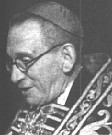
(25) 25. ARCE Y OCHOTORENA, Manuel
(1879-1948)
Birth. August 18, 1879, parish of San Julián de Ororbia, diocese of Pamplona, Spain. Youngest of the seven children, six boys and a girl, of Pedro Arce and Lorenza Ochotorena (1837-1929), merchants. Five of his brothers emigrated successively to the island of Cuba, where his brother Pedro undertook an important business. He showed since childhood a particular inclination to study and religious life.
Education. Studied at the Conciliar Seminary of Pamplona since he was twelve years old, where he brilliantly studied three years of Humanities, three of Philosophy and three of Theology; he completed his theological training at the Pontifical Seminary of Zaragoza from 1900 to 1902, obtaining a doctorate in Theology, deserving the prize in Theological Disquisitions and the highest qualification in Sacramental Dogma, awarded for the first time in that teaching center; later, he obtained a scholarship from his diocese, and was sent to Rome, where he studied canon law, Sacred Scripture and Oriental Languages at the Pontifical Gregorian University from 1902 to 1905), having also obtained a doctorate in philosophy from the Accademia Santo Tommaso d'Aquino in 1904; and a doctorate in canon law in that same institution in 1905).
Priesthood. Ordained, July 17, 1904, Pontifical Spanish Collegio, Rome. Faculty member of the Conciliar Seminary of Pamplona. Doctoral canon of Pamplona in 1914. Vicar capitular in 1922. Vicar general in 1923. Apostolic protonotary, December 3, 1926.
Episcopate. Elected bishop of Zamora, Spain, February 5, 1929. Consecrated, June 16, 1929, cathedral of Pamplona, by Federico Tedeschini, titular archbishop of Lepanto, nuncio to Spain, assisted by Tomás Muniz Pablos, bishop of Pamplona, and by Mateo Múgica y Urrestarazu, bishop of Vitoria. His episcopal motto was Christus formetur ut in orbis. Transferred to the see of Oviedo, January 22, 1938. During his episcopate in Oviedo, he worked in the reconstruction of both spiritual and material problems, as following the Spanish Civil War, there was no cathedral, seminary, episcopal palace, more than four hundred churches had been destroyed and one hundred and thirty priests had been assassinated. He managed the restoration of the cathedral, placed the first stone of the new seminary and the episcopal palace and initiated work on the construction of two hundred churches. Promoted to the metropolitan see of Tarragona, March 29, 1944. He took possession of the archdiocese on the following October 26; upon his entry on November 12, he received a triumphant reception. President of the Patronato del Real Monasterio de Santa María de Poblet. He was decorated with the grand cross of the Order of Isabel la Católica.
Cardinalate. Created cardinal priest in the consistory of February 18, 1946; received the red hat and the title of Ss. Vitale, Valeria, Gervasio e Protasio, February 22, 1946. Papal legate to the celebrations of Our Lady of Montserrat, Montserrat, April 12, 1947.
Death. September 16, 1948, at 9:50 p.m., of an internal hemorrhage caused by duodenal ulcers, at the archiepiscopal palace of Tarragona. Buried in a specifically built sarcophagus in the chapel of the baptistry of the metropolitan cathedral of Tarragona (1).
Bibliography. Echeverría, Lamberto de. Episcopologio español contemporáneo, 1868-1985 : datos biográficos y genealogía espiritual de los 585 obispos nacidos o consagrados en España entre el 1 de enero de 1868 y el 31 de diciembre de 1985 . Salamanca : Universidad de Salamanca, 1986. (Acta Salmanticensia; Derecho; 45), p. 91.
Webgraphy. Biography by Vicente Cárcel Ortí, in Spanish, Diccionario Biográfico Español, DB~e; his tomb, fourth photo on the page, Diputación Tarragona; his photograph and arms, Araldica Vaticana.
(1) This is the text of the inscription on his tomb, kindly provided by Mr. Eman Bonnici, from Malta:
EMMVS CARD TITVLI SCI VITALIS EMMANVEL ARCE OCHOTORENA ARCHIEP TARRAC HISP PRIM MDCCCXXIX - MCMXLVIII REQVIESCAT IN PACE
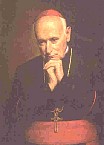
(26) 26. MINDSZENTY, József
(1892-1975)
Birth. March 29, 1892, Csehimindsent, diocese of Szombathely, Hungary. Son of János Pehm and Borbála Kovács. He had five siblings, three of which died in infancy; two sisters survived. He took the name of his native town as his last name.
Education. Studied at the Seminary of Szombathely.
Priesthood. Ordained, June 12, 1915, Szombathely, by János Mikesde Zabola, bishop of Szombathely. Pastoral ministry in the diocese of Szombathely, 1915-1944. Arrested during the Communist revolt of Bela Kun, 1919.
Episcopate. Elected bishop of Veszprém, March 3, 1944. Consecrated, March 25, 1944, metropolitan cathedral basilica of Esztergom, by Cardinal Jusztinian Séredi, O.S.B., archbishop of Esztergom, assisted by Lajos Shvoy, bishop of Székesfehérvár, and by József Pétery, bishop of Vác. His episcopal motto was Pannonia sacra. Imprisoned by the Nazi regime, 1944-1945. Promoted to the metropolitan and primatial see of Esztergom, October 2, 1945.
Cardinalate. Created cardinal priest in the consistory of February 18, 1946; received the red hat and the title of S. Stefano al Monte Celio, February 22, 1946. He continued to use the feudal title of prince-primate (hercegprímás) even after the use of nobility, peerage and royal titles were entirely outlawed by the 1946 Parliament. Condemned to life imprisonment by the Communist regime, March 1949. Freed by the Hungarian revolt, October 1956. In political asylum in the United States of America embassy, Budapest, 1956-1971. Did not participate in the conclave of 1958, which elected Pope John XXIII. Did not participate in the conclave of 1963, which elected Pope Paul VI. Left Hungary, September 28, 1971. Lost the right to participate in the conclave when turned eighty years of age, March 29, 1972. Considering the pastoral problems of the archdiocese, Pope Paul VI asked him to resign its government; the see was declared vacant and an apostolic administrator ad nutum Sanctae Sedis appointed, February 2, 1974; the apostolic administrator named was László Lékai, titular bishop of Giro di Tarasio, until then apostolic administrator, ad nutum Sanctæ Sedis, of Veszprém.
Death. May 6, 1975, at 2:14 p.m., of heart failure, hospital of the Brothers of Mercy, in Vienna, about four hours after undergoing prostate surgery. Buried, temporarily, Hungarian chapel, Shrine of Mariazell (1). His body was transferred to the metropolitan and primatial cathedral of Esztergom on May 4, 1991 (2).
Beatification. Beatification process started by the Congregation for the Causes of the Saints, October 22, 1996. On February 12, 2019, Pope Francis authorized the Congregation of the Causes of the Saints to publishe the decree concerning his heroic virtues.
Bibliography.
-Cardinal Mindszenty speaks ; authorized white book, pub. by order of Joseph Cardinal Mindszenty. Introduction by Akos Zombory. New York : Longmans, Green, 1949. Notes: A translation of papers selected from those sent out of Hungary by Cardinal Mindszenty. A similar publication in German was issued under the title: Weissbuch; vier Jahre Kirchenkampf in Ungarn;
-Fabian, Bela. Cardinal Mindszenty. New York : C. Scribner's Sons, 1949;
-Houston, J. Cardinal Mindszenty. London : Catholic Truth Society, 1979;
-Lesourd, Paul. Le cardinal Mindszenty; primat de Hongrie. Paris : France-Empire, 1972. Note: At head of title: Héros, confesseur, et martyr de la foi;
-Mindszenty, József. Memoirs. Translation of Erinnerungen. New York : Macmillan Publishing Co., 1974;
-Mindszenty, József. Mindszenty-Dokumentation. 2 vols. Bearbeitet und übersetzt von Josef Vecsey und Johann Schwendemann. [s.l] : Sonderausgabe im Selbstverlag der Verfasser, 1956- ; Pölten : Pressvereins-Druckerei;
-Shuster, George N. In Silence I Speak. The Story of Cardinal Mindszenty. Today and of Hungary's "New Order". With the research assistance of Dr. Tibor Horanyi. New York : Farrar, Straus and Cudahy, 1956;
-Swift, Stephen. The cardinal's story. The life and work of Joseph, Cardinal Mindszenty, archbishop of Esztergom, primate of Hungary. New York : Macmillan, 1949;
-Vecsey, Joseph. Mindszenty the man. St. Louis : Cardinal Mindszenty Foundation, 1972;
-Tusor, Péter. Purpura Pannonica : az esztergomi "bíborosi szék" kialakulásának elozminyei a 17. században = Purpura Pannonica : the "Cardinalitial See" of Strigonium and its Antecedens in the 17th Century. Budapest : Róma : Research Institute of Church History at Péter Pázmány Catholic University, 2005. (Collectanea Vaticana Hungariae, Classis I, vol. 3), pp. 210 and 330;
-Vecsey, Josef; Navalis, Carlo; Franzel, Emil. Kardinal Mindszenty: Das Gewissen der Welt. Würzburg : Johann Wilhelm Naumann, 1972;
-Vecsey, József ; Varga, László; Mindszenty, József. Kardinal Mindszenty : Beiträge zu seinem siebzigsten Geburtstag. München : Donau Verlag, 1962.
Webgraphy. Biography, in English, Encyclopaedia Britannica; photographs and biography, in English, Wikipedia; The Life and "Crimes" of Cardinal Jozsef Mindszenty by Alice Rethinger Watson, in English, CatholicCulture.org; Cardinal Mindszenty Foundation, in English; photographs, portrait and arms, Araldica Vaticana; Venerabile Jozsef Mindszenty Cardinale, Primate d’Ungheria by Paolo Risso, Santi e Beati; Il Cardinal Erdoe Sulla Cstituzione Ungherese E Sul Cardinal Mindszenty, Rossoporpora, ottobre 31, 2012; Quella «visita» di Padre Pio nella cella del cardinal Mindszenty by Andrea Tornielli, Vatican Insider, 2/07/2014; Quando l’eroismo del cardinal Mindszenty ispirava i vescovi italiani by Omar Ebrahime, Il Corriere del Sud, 11 Settembre 2015; Ricordare per riflettere: József Mindszenty (1892-1975) by Italo Francesco Baldo, La Domenica di Vicenza, nr. 35 anno XX del 3 ottobre 2015 ; La fe vence al mundo: El legado de un Cardenal torturado por comunistas by Walter Sánchez Silva, ACI Prensa, 3 de mayo de 2018 8:13 pm; Il martire Mindszenty: il cardinale contro il comunismoby Silvia Vazzana, Secolo Trentino, 6 Gennaio 2019; Cardinal Jozsef Mindszenty, Venerable Crime Fighter by Peter Kengor, National Catholic Register, Feb. 26, 2019; Diplomat recalls friendship with Hungarian cardinal who's up for sainthood by Jodi Marlin, The Boston Pilot, CNS, Fort Wayne, Ind., 5/13/2020; The cardinal tortured who opposed Vatican compromises by Rino Cammilleri, Daily Compass, 03-09-2020; L’attualità dell’esempio di József Mindszenty, eroico primate d'Ungheria, Vatican News, L'Osservatore Romano, 07 maggio 2021, 16:46; Cardinal Czerny remembers famous Hungarian Cardinal Mindszenty on 46th anniversary of his death by Gerard O’Connell, America, The Jesuit Review, May 07, 2021; Cardinal Mindszenty and the recovery of heroic Christian virtue by Daniel J. Mahoney, The Catholic World Report, October 14, 2022; Cardinal Mindszenty’s Memoirs are “deeply informative, moving, and spiritually and politically instructive” by Paul Senza, The Catholic World Report, March 2, 2023; La mancata visita di Francesco alla tomba del card. József Mindszenty (Esztergon-Budapest) è triste per i cattolici ungheresi e non solo, Il Sismigrafo, giovedì 9 marzo 2023; The Cardinal who stared down Communism by Sean Salai, The Catholic World Report, April 2, 2023.
(1) This is the text of the inscription on his burial site, kindly provided by Mr. Eman Bonnici, from Malta:
JOSEPHUS CARDINALIS MINDSZENTY ARCHIEPISCOPUS STRIGONIENSIS PRINCEPS PRIMAS HUNGARIAE MDCCCXCII ∼ MCMLXXV HOC SUB LAPIDE REQUIEVIT AB ANNO MCMLXXV USQUE AD ANNUM MCMXCI PANNONIA LIBERATA DIE TERTIO MENS MAI ANNO MCMXCI IN PATRIAM SUAM REVERTIT VIXIT ET VIVAT
(2) This is the text of the inscription on his tombstone, also provided by Mr. Bonnici:
VITA HUMILIAVIT﹣MORS EXALTAVIT S.R.E. TIT. S. STEHPANI IN COELIO MONTE PRESB. CARDINALIS ULTIMUS PRINCEPS PRIMAS HUNGARIAE ARCHIEP. STRIGON. FIDELISSIMUS IN TRIBULATIONE PASTOR JOSEPHUS MINDSZENTY 29.MART. 6. MAI 1892 1975 BELLI IMPETU FIRMUS TYRANNICA POTESTATE CRUCIATUS AD CARCEREM DAMNATUS PATRIAE EXSUL OBEDIENS ROMANAE MATRIS ECCLESIAE FILIUS AMATISSIMAE·PATRIAE·HONESTATIS·CULTOR·USQUE·AD·MORTEM·PERMANSIT IN CELLA MARIAE SEPULTUS ANNO XVI° POST OBITUM TRANSLATUS HIC IN PACE QUIESCIT
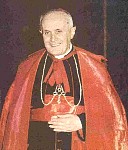
(27) 27. RUFFINI, Ernesto
(1888-1967)
Birth. January 19, 1888, San Benedetto Po, diocese of Mantua, Italy. Fifth of the eight children of Giovanni Ruffini and Domenica Gentilini. He was baptized on February 22, 1888. Received the sacrament of confirmation on May 30, 1896; and the first communion on Palm Sunday 1898.
Education. Studied at the Seminary of Mantua from 1898 to 1910; took the vow of chastity in 1902; renew the vow perpetually, with the consensus of his spiritual director, on June 21, 1904; at the Pontifical Theological Faculty of Northern Italy, Milan (licentiate in theology, September 17, 1910); resided at Collegio Leoniano, Rome, 1910-1913; during this time, his spiritual director was Monsignor Vincenzo Tarozzi, future servant of God; at the Pontifical Academy of S. Tommaso, Rome (licentiate in philosophy, January 19, 1911); and at the Pontifical Biblical Institute, Rome (diploma to teach Biblical Science, Summer 1913).
Priesthood. Ordained, July 10, 1910, chapel of the Incoronata, cathedral of Mantua, by Paolo Carlo Origo, bishop of Mantua. Further studies, 1910-1913. Took part in the first study travel to the Holy Land organized by the Pontifical Biblical Institute, Rome, November 6 to 15, 1913. Faculty member of the Pontifical Athenaeum of Major Roman Seminary, Rome, 1913-1930. Faculty member of the Pontifical Urbanian Athenaeum "De Propaganda Fide," 1917-1929. In 1924, he was named diocesan delegate for Rome of the Missionary Union of the Clergy; examiner of the Roman clergy; and substitute for censorship of books in the Supreme S.C. of the Holy Office. Domestic prelate of His Holiness, March 1, 1927. Secretary of the S.C. of Seminaries and Universities, October 28, 1928. Prefect of studies of the Pontifical Lateran Athenaeum, 1930; its rector magnifico, 1931-1932. Protonotary apostolic, June 15, 1931. President of the Academy of the Immaculate Conception of the Blessed Virgin Mary, Rome. Member of the papal delegation to the International Eucharistic Congress celebrated in Buenos Aires, Argentina in 1934. Founder of the Medical-biological Union "S. Luca", Rome, 1944.
Episcopate. Elected archbishop of Palermo, Sicily, October 11, 1945. Consecrated, December 8, 1945, church of S. Ignazio, Rome, by Cardinal Giuseppe Pizzardo, prefect of S.C. for Seminaries and Universities, assisted by Francesco Borgongini Duca, titular archbishop of Eraclea di Europa, nuncio to Italy, and by Domenico Menna, bishop of Mantua. His episcopal motto was Firmiter stat.
Cardinalate. Created cardinal priest in the consistory of February 18, 1946; received the red hat and the title of S. Sabina, February 22, 1946. Apostolic administrator of the eparchy of Piana degli Albanesi, January 3, 1947. Apostolic administrator sede vacante of Trapani, April 8 to November 10, 1947; and again, December 17, 1950. Apostolic administrator sede vacante of Mazara del Vallo, August 18, 1948. Papal legate to the National Eucharistic Congress and to the Congress of Sacerdotal Vocations, Rosario, Argentina, September 6, 1950; received a doctorate honoris causa in law from the University of Buenos Aires. Papal legate to the Second Sicilian Plenary Council, Palermo, December 20, 1951. Founder of the Missionary Social Assistants, March 25, 1954. Received a doctorate honoris causa in philosophy from the University of Palermo on June 9, 1956. Participated in the conclave of 1958, which elected Pope John XXIII. Attended the Second Vatican Council, 1962-1965; member of its board of presidency, 1962-1965. Participated in the conclave of 1963, which elected Pope Paul VI. Honorary citizen of Palermo, November 4, 1964.
Death. Sunday June 11, 1967, at 11 a.m., unexpectedly, of a heart attack, after having voted in the regional elections and while he was preparing to celebrate Mass in Bonagia, one of the poorest areas of Palermo; he received the last rites (1). On Monday June 12, at 8 p.m., the body was placed in a zinc casket, which was placed inside another one of mahogany; according to his will, a Bible was placed inside the casket; a lead tube containing a eulogy was also placed in the casket (2). Exposed in the archiepiscopal palace of Palermo; the funeral, celebrated by Filippo Aglialoro, titular bishop of Germa di Galazia, auxiliary and vicar general of Palermo, took place in the metropolitan cathedral of Palermo on Tuesday June 13, at 5:30 p.m; Cardinal Ermenegildo Florit, archbishop of Florence, imparted the final absolution; twenty archbishops and bishops were in attendance, besides the mayor and councilmen of Palermo and other civil dignitaries. Buried, according to his will, next to the altar of the Madonna, on the left side, in the shrine of "Madonna dei Rimedi", Palermo (3).
Bibliography. Gambio, Emmanuele. Il pastore sulla breccia, Ernesto card. Ruffini. Roma : Ancora, 1967; Petralia, Giuseppe. Il cardinale Ernesto Ruffini, arcivescovo di Palermo. Città del Vaticano : Libreria Editrice Vaticana, 1989.
Webgraphy. Photographs, bibliography and extensive biography, in Italian, Wikipedia; his photograph and arms, Araldica Vaticana; L’opzione per i poveri. All’Università di Salamanca una sessione sul cardinale Ruffini, L'Osservatore Romano, Salamanca, 21 ottobre 2022.
(1) Text of his spiritual testament, taken from Gambio, Il pastore sulla breccia, Ernesto card. Ruffini, p. 263:
Innanzitutto ringrazio di tutto cuore il Signore per i molteplici favori e grandi doni che mi ha elargito, specialmente chiamandomi al Sacerdozio e alla pienezza del Sacerdozio; ci vorrà l'eternità perchè io possa effondere meno inadeguatamente la mia riconoscenza per gli innumerevoli benefizi ricevuti dalla misericordia di Dio per la mediazione della mia dolcissima Madre celeste, Maria Santissima. Ringrazio pure tutti coloro che mi hanno aiutato con l'opera, con l'esempio, con la preghiera. Chiedo umilmente perdono al Signore dei miei peccati, delle offese recateGli e delle negligenze commesse nel suo servizio. Professo fede fermissima a quanto il Signore ha rivelato e la Santa Chiesa Apostolica Romana propone da credere. Ho consacrato molti anni allo studio della Sacra Scrittura e confesso di averne tratto sempre maggior conferma della mia Fede e impulso a bene operare. Rinnovo la mia profunda, commossa devozione alla Ss. Eucaristia e alla Madonna, alla quale mi sono consacrato con un voto speciale da più di cinquanta anni. Approvo pienamente e confermo con entusiasmo gli altri tre voti, da me emessi con l'approvazione del veneratissimo Mons. Vincenzo Tarozzi (+ 1918), di castità perfetta, di umiltà (non cercare mai onori, ed accettarli soltanto quando risultassero con certezza di maggior gloria di Dio) e di perfezione. Chiedo umilmente perdono a quanti avessi offeso, recato loro molestia, o dato cattivo esempio. Per parte mia non ho nulla da perdonare: amo tutti coloro che ho conosciuto, e raggiungendo per divina bontà il Paradiso, tutti porterò con me e mi interesserò della loro salvezza eterna, onde stare poi sempre in loro compagnia beatamente. Ho sempre amato la povertà -- sono fin da giovane Sacerdote Terziario Cappuccino -- e godo di morire senza proprietà alcuna di beni immobili, povero per i miei poveri, che tanto da vicino mi rappresentano Gesù Cristo, mio dolce Salvatore. Il Seminario e i Sacerdoti hanno formato la pupilla dei miei occhi. Se i Sacerdoti saranno tutti buoni, uomini di orazione e perfettamente obbedienti al loro Arcivescovo, faranno miracoli e l'Archidiocesi di Palermo (con l'Eparchia), attesa l'eccezionale bontà del suo popolo, diventerà presto esemplare sotto ogni aspetto. Dopo il Seminario e il Clero mi sta sommamente a cuore l'Istituto delle Assistenti Sociali Missionarie, da me fondato. Credo mi sia stato ispirato dalla Madonna, che ne è e ne sarà sempre la suprema Direttrice e Moderatrice: esso risponde certamente a una grande necessità dei tempi nostri nel vasto campo dell'apostolato cristiano. Considero le Assistenti Sociali Missionarie vere Madri Sociali nel nome del Redentore divino Gesù Cristo. Esse potranno entrare in tutti i settori sociali, per portare ovunque lo spirito dell'Evangelo e per preparare innumerevoli anime al sacro ministero dei Sacerdoti. È però assolutamente necessario che siano animate tutte e singole di grande spirito di orazione, di mortificazione e di carità. Desidero essere sepolto -- se nulla osterà -- nella Chiesa della Madonna dei Rimedi, presso l'altare della Madonna, a sinistra di chi La guarda.
(2) This is the text of the eulogy (taken from Gambio, Il pastore sulla breccia, Ernesto card. Ruffini, p. 251-252), which was composed by Msgr. Salvatore Cambria, chancellor of the archiepiscopal Curia, and subscribed by Filippo Aglialoro, titular bishop of Germa di Galazia, auxiliary and vicar general of Palermo, by the metropolitan chapter and by the civil authorities and others:
ERNESTUS RUFFINI, die XIX m. ianuarii anni millesimi octingentesimi octuagesimi octavi in oppido vulgo " S. Benedetto Po " dioecesis Mantuanae natus, inde a pueritia sacerdotalia munera percupiit. Studiorum curriculo emenso et laurea doctorali donatus, die decima m. iulii a. MCMX primum sacrum litavit. Castitatem ex voto inde a teneris annis illaesam servavit et coluit, pietate in Deum enituit, eximia devotione erga Beatissimam Virginem flagravit. A Sancto Pio X, cui apprime carus fuit, integra valetudine donatus, ipse munus docendi Sacram Scripturam in Pont. Seminario ad Lateranum accepit, quod postea in Pont. Athenaeo Urbaniano cumulavit, donec a Pio Pp. XI "a Secretis Sacrae Congregationis de Seminariis et Studiorum Universitatibus" renuntiatus fuit. Quo in munere multa egregia navavit ad studia ecclesiastica provehenda, eiusque opera et ingenio prodiit Const. Apost. "Deus scientiarum Dominus". Quem virum, tantis decoratum animi ornamentis, Pius XII Pontifex Maximus, anno MCMXLV, in lesto Divinae Maternitatis, ad cathedram S. Mamiliani evexit, asserens se nihil melius habere in Urbe ut Panormum ditaret. Inter Purpuratos Patres cooptatus, die XXXI m. martii anni subsequentis Fanormum venit ac, inenarrabili laetitia exceptus, omnium animos sibi devinxit, immo ipse devinctus est. Felix enim urbs, teterrimo bello vix exstincto, innumera vulnera prae se ferebat, ubique erat squalidior egestas. Propterea effecit ut Fanormum re "felicis urbis" appellationem iterum consequeretur. Boni Pastoris officio optime functus est; quater universam archidioecesim lustravit; ministerium verbi, doctrina et facundia, mire exercuit; Seminarium Archiepiscopale, sive maius sive minus, novis aptisque aedificiis ditavit, ac, ad peculiarem institutionem neo-mystarum, Institutum Pastorale a sancto Curato d'Ars nuncupatum, excitavit et amplificavit; inopes effusa caritate et summa liberalitate fovit. In postulationes temporum intentus, Institutum saeculare " Assistenti Sociali Missionarie " fundavit, quod, rite ab Ecclesia probaturo, fines archidioeceseos cum praetergressum esser, peculiarem apostolatum exercet in plures dioeceses Italiae, Hispaniae et Americae Latinae. Compiorati Erm.mi Praesulis alacritas omnino mira fuit, tum in partes Ecclesiae tum in partes ad societatem hominum pertinentes. Erectis nato quadraginta novis paroeciis, affabre a fundamentis viginti ecclesias paroeciales et domus canonicas excitavit, ne verbum dicamus de ecclesiis refectis et de cura in cathedralem ecclesiam impensa. Praeclara monumenta caritatis ipsius erga egenos exstant quae italice nuncupantur : Villaggio Card. Ruffini - Istituto Angelo Custode - Casa della Gioia.- Villaggio dell'Ospitalità - Casa della Serenità - Centro di formazione professionale et alia. Omnibus compertum est qua alacritare interfuit Concilio Oecumenico Vaticano II, ut Christi Ecclesia, ad novum renata vigorem, efficaciore virtute salutiferum suum munus expleret. Die XI m. iulii a. MCMLXVII, lato suffragio ad renovandum concilium (assemblea) regionis siculae, profecturus ad sacrum faciendum in oratorio loci vulgo "Bonagia", repentino morbo correptus, sacramentis Ecclesiae refectus, pitssime animare Deo reddidit hora undecima, comploratus ab universa archidioecesi et ab bominibus cuiusvis gradus. Ut Summi Pontificis utar verbis "ut bonus miles Christi in acri occubuit". Christus ipse, intercedente Deipara Virgine, quam semper in ore et in corde gessit, Patri ac Pastori desideratissimo ianuam superni regni patefaciat, eique praemia promerita impertiat.
(3) This is the text of his epitaph, composed by the cardinal and included at the end in his spiritual testament, taken from Gambio, Il pastore sulla breccia, Ernesto card. Ruffini, p. 263:
+ ERNESTO CARDINALE RUFFINI Arcivescovo di Palermo e Amministratore Apostolic di Piana degli Albanesi 19-1-1888 11-6-1967 « Tanto amó la Madonna in vita che ha voluto essere sepolto accanto a Lei »
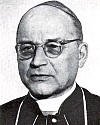
(28) 28. PREYSING, Konrad von
(1880-1950)
Birth. August 30, 1880, castle of Kronwinkel, archdiocese of Münich and Freising, Germany, of a noble family. Son of Kaspar von Preysing and Hedwig von Walterskirchen. His baptismal name was Johann Konrad Maria Augustin Felix. His last name is also listed as von Preysing Lichtenegg-Moos. His brothers Albert and Joseph also entered the priesthood. Cousin of Cardinal Clemens August von Galen (1946).
Education. He studied at the Gymnasium of Langshut, Lanfshut; at the University of Münich from 1898 to 1901; at the University of Würzburg from 1901 to 1902; and at the Theological Faculty of Innsbruck from 1908 to 1913 (philosophy and theology; obtained a doctorate in theology in 1913).
Priesthood. Ordained, July 29, 1912, Innsbruck. Secretary to Cardinal Franz von Bettinger, archbishop of Münich and Freising, July 8, 1912-1916; as secretary of the cardinal, he attended the conclave of 1914, which elected Pope Benedict XV. Pastoral ministry in the archdiocese of Münich and Freising, 1916-1932; canon of the cathedral chapter, April 1, 1928-1932. Honorary chamberlain of His Holiness, May 15, 1914; reappointed, November 9, 1914, and September 25, 1922.
Episcopate. Elected bishop of Eichstätt, Germany, September 9, 1932. Consecrated, October 28, 1932, cathedral of Eichstätt, by Jacobus Hauck, archbishop of Bamberg, assisted by Matthias Ehrenfried, bishop of Würzburg, and by Sigmund Ow Felldorf, bishop of Passau. His episcopal motto was In Verbo tuo. Transferred to the see of Berlin, July 5, 1935. Assistant at the Pontifical Throne, July 15, 1937. Strongly opposed the Nazi regime in Germany.
Cardinalate. Created cardinal priest, February 18, 1946; received the red hat and the title of S. Agata de' Goti, deaconry elevated pro illa vice to title, February 22, 1946 (1).
Death. December 21, 1950, in the afternoon, of a heart attack, at his home in the United States sector, Berlin. On December 28, 1950 he was buried in the cemetery "St. Hedwig, Liesenstrasse", Berlin-Mitte; on February 12, 1968, reburied in the crypt of the cathedral of St. Hedwig, Berlin, after this church was rebuilt (it had been destroyed in the Second World War) (2). The Konrad-von-Preysing-Haus, a residential community for adults with mental disabilities sponsored by the Caritas Association Frankfurt is named in his honor. The Deutsche Bundespost Berlin commemorated him with a 50 pfennig stamp in 1980.
Bibliography. Adam, Stephan. Die Auseinandersetzung des Bischofs Konrad von Preysing mit dem Nationalsozialismus in den Jahren 1933 bis 1945. St. Ottilien : EOS Verlag, 1996; Gatz, Manfred Clauss-Erwin. "Preysing, Graf Konrad von (1880-1950)." Die Bischöfe der deutschsprachigen Länder, 1785/1803 bis 1945 : ein biographisches Lexikon. Herausgegeben von Erwin Gatz. Berlin : Duncker & Humblot, 1983, pp. 573-576; Knauft, Wolfgang. Konrad von Preysing, Anwalt des Rechts : der erste Berliner Kardinal und seine Zeit. Berlin : Morus, 1998; Konrad Kardinal von Preysing, Bischof von Berlin. Zur Vollendung seines 70. Lebensjahres herausgegeben vom Bischöflichen Ordinariat Berlin. Berlin : Morus, 1950.
Webgraphy. Photographs and biography, in German, Bayerischer Wald; his arms and photographs, Araldica Vaticana; Il Cardinale von Preysing, un fiero oppositore del nazismo by Marco Mancini, ACI Stampa, Berlino, 21 dicembre, 2020 / 9:00 AM.
(1) Spending all his resources to relieve suffering, Bishop von Preysing, when he was created cardinal, had to obtain money for the trip to Rome from Archbishop Angelo Roncalli, nuncio in France. At the 1946 consistory, one of the other new cardinals tried to make small talk by remarking to Bishop von Preysing that when they died, their red hats would be suspended from the ceilings of their respective cathedrals, to which the German cardinal, thinking of his bombed out cathedral, replied, "Your Eminence forgets that I have no roof."
(2) This is the inscription on his vault, kindly provided by Mr. Eman Bonnici, from Malta:
IN VERBO TUO KONRAD CARDINAL VON PREYSING BISCHOF VON BERLIN 5.7.1935 - 21.12.1950
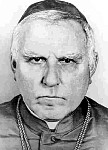
(29) 29. GALEN, Clemens August von
(1878-1946)
Birth. March 16, 1878, Dinklage Castle, Oldenburg, diocese of Münster, Germany. He was the eleventh of the thirteen children of Count Ferdinand von Galen and Elisabeth von Spee. He received first communion on April 27, 1890, in the parish church of Dinklage. Cousin of Cardinal Konrad von Preysing(1946). His uncle, Gereon Maximilian Graf von Galen (1832-1908), was the auxiliary bishop of the diocese of Münster and a renowned theologian.
Education. Studied at "Stella Matutina" Jesuit secondary school, Feldkirch, Austria, until Summer of 1894; at the Catholic public school "Antonianum," Vehcta, 1894-1896 (obtained his "leaving certificate," Summer of 1896); at the Catholic University of Fribourg, Switzerland, Spring of 1897 (philosophy); travelled to Rome in the Spring of 1898; attended a Mass celebrated by Pope Leo XIII; made a retreat at the Benedictine abbey of Maria-Laach, Switzerland; decided to become a priest; studied at "Canisianum" Jesuit Theological College, Innsbruck, Fall of 1898 until 1903; and at the Seminary of Münster (theology), 1903-1904.
Priesthood. Ordained, May 28, 1904, cathedral of Münster, by Hermann Dingelstad, bishop of Münster. Assistant priest at the cathedral of Münster, 1904-1906; at the same time, he was commissioned to accompany his uncle, Bishop Maximilian Gereon von Galen, auxiliary of Münster, on his pastoral visits to confer the sacrament of confirmation. Assistant priest, and later curatus at St. Matthias church, Berlin, 1906-1929. In Berlin, he lived through the difficult times of the First World War, the troubled post-war years and a great part of the Weimar Republic. Called back to Münster in 1929 and appointed parish priest of St. Lambert's; he started his ministry on April 24, 1929. In 1932, he completed his work Die Pest des Laizismus und ihre Erscheinungsformen, which dealt with the secularization of human society and the rejection of God and his laws. That same year he protested the dissolution by the German authorities of the Young Men's Association.
Episcopate. Elected bishop of Münster, September 5, 1933. Consecrated, October 28, 1933, cathedral of Münster, by Cardinal Karl Josef Schulte, archbishop of Cologne, assisted by Wilhelm Berning, bishop of Osnabrück, and by Franz Rudolf Bornewasser, bishop of Trier; his episcopal motto was Nec laudibus nec timore (Neither 0 praise nor fear) (1). Invited to go to Rome, together with other German bishops, to discuss the situation in Germany with Pope Pius XI and to prepare the encyclical letter Mit brennender Sorge(With burning anxiety), which condemned the policies of the National Socialist regime before the world. For his courage and strong opposition to the Nazi regime in Germany was called the "Lion of Münster." In the church of St. Lambert on July 13, 1941 and August 3, 1941, and in the church of Our Lady in Überwasser, on July 20, 1941, he delivered three celebrated homilies against Adolf Hitler's regime. In those occasions the bishop of Münster expressed himself in defense of the right to life, of the inviolability and the freedom of its sick citizens, and harshly censured the killing of the psychologically ill (2). Assistant at the Pontifical Throne, September 13, 1943.
Cardinalate. Created cardinal priest in the consistory of February 18, 1946; received the red hat and the title of S. Bernardo alle Terme, February 22, 1946. On his return to Münster, he was greeted by sixty thousand people gathered in front of his cathedral, however, he was already too weary to address them.
Death. March 22, 1946, at about 5 p.m., of peritonitis, a few days after his return from Rome, in St. Franziskus Hospital of Münster, due to an appendix infection diagnosed too late (3). The lying-in-state lasted four days in the Erpochapel of the church of St. Maurice. Three cardinals, including Bernard Griffin of Westminster, attended the funeral celebrated in the cathedral of Münster. His body was buried on March 28, 1946 in the Galen chapel, in that cathedral, which was in ruins because of the war; the chapel's door had been walled up since the 17th century when the last prince-bishop, Christoph Bernard von Galen, was interred there (4). Two stamps commemorating him on the twentieth and fiftieth anniversaries of his death have been issued by the Deutsche Bundespost Berlin in 1966 and 1996 respectively.
Beatification. The decree concerning his heroic virtues was promulgated by the Congregation for the Causes of the Saints on December 20, 2003; the decree concerning a miracle attributed to his intercession was promulgated on December 20, 2004. The ceremony of his beatification took place on Sunday October 9, 2005, at 10 a.m., in the patriarchal Vatican basilica, presided in the name of Pope Benedict XVI by Cardinal José Saraiva Martins, C.M.F., prefect of the Congregation for the Causes of the Saints. His feast is celebrated on March 22.
Bibliography.
-Bierbaum, Max. Nicht Lob, nicht Furcht : das Leben des Kardinals von Galen nach unveröffentlichten Briefen und Dokumenten. Münster : Verlag Regensburg, 1955;
-Clemens Augusut Graf von Galen : neue Forschungen zum leben und wirken des bischofs von Münster. Münster : Regensburg, 1992;
-Falasca, Stefania ; Galen, Clemens August ; Pius; XII. Un vescovo contro Hitler : Von Galen, Pio XII e la resistenza al nazismo. Cinisello Balsamo (Milano) : San Paolo, 2006. (Attualità e storia ; 83);
-Fehrenbach, Jérôme. Von Galen : un évêque contre Hitler. Paris : Éditions Du Cer, 2018;
-Galen, Clemens August von. Akten, Briefe und Predigten, 1933-1946. 2 vols. Bearbeitet von Löffler, Peter. 2d ed. Paderborn : Schoöningh, 1996;
-Galen, Clemens August von. Les sermons de S. Exc. Mgr von Galen, Évêque de Münster (Westphalie). Fribourg : Ed. "Pro Deo et Patria", 1942;
-Hegel, Eduard. "Galen, Clemens August Graf von." Die Bischöfe der deutschsprachigen Länder, 1945 2001 : ein biographisches Lexikon. Unter Mitwirkung von Franz Xaver Bischof ... [et al.] ; herausgegeben von Erwin Gatz. Berlin : Duncker & Humblot, 2002, p. 406-408;
-Klocke, Imgard. Kardinal von Galen. Der Löwe von Münster. Münster : Pattloch, 1978;
-Knecht, Thierry. Mgr von Galen. L'évêque qui a défié Hitler. Paris : Parole et silence, 2007. (Cahiers de l'école cathédrale ; 79);
-Kuropka, Joachim. Clemens August Graf von Galen. Neue Forschungen zum Leben und Wirken des Bischofs von Münster. 2 vols. Münster : Verlag Regensburg, 1992;
-Kuropka, Joachim. Clemens August Graf von Galen : Menschenrechte, Widerstand, Euthanasie, Neubeginn. Münster : Regensburg, 1998;
-Morsey, Rudolf. Clemens August Kardinal von Galen zum Gedächtniss. Versuch einer historischen Würdigung. Münster : Verlag Regensburg, 1966;
-Portmann, Heinrich. Kardinal von Galen. Ein Gottesman seiner Zeitung. Münster : Aschendorff, 1974;
-Portmann, Heinrich. Kardinal von Galen : ein Gottesmann seiner Zeit. Edition: Neuaufl. Münster : Aschendorff, 2005. Note : Original: 1e dr.: 1948;
-Portmann, Heinrich. Cardinal von Galen. Translated by R.I. Sedgwick. London : Jarrols, 1957;
-Sandstede-Auzelle, Marie-Corentine. Clemens August Graf von Galen, Bischof von Münster im Dritten Reich. Münster : Aschendorff, 1986;
-Utrecht, Daniel. The Lion of Münster : The Bishop Who Roared Against the Nazis. Charlotte, NC : Tan Books, 2016;
-Wolf, Hubert. Clemens August von Galen. Ein Kirchenfürst im Nationalsozialismus. Darmstadt : Wiss. Buchges, 2007;
-Wolf, Hubert ; Flammer, Thomas ; Schüler, Barbara. Clemens August von Galen. Ein Kirchenfürst im Nationalsozialismus. Darmstadt : WBG, Wissenschaftliche Buchgesellschaft, 2007.
Webgraphy. Photograph and biography, in English, The Vatican; pictures and chronology, in German, Deutsches Historisches Museum; biography, in English, Encyclopaedia Britannica; photograph and biography, in German; The Lion of Münster and Pius XII (Clemens August von Galen) by Stefania Falasca, in English, storialibera; his arms, photographs, portraits, postal card, and memorial plaque, Araldica Vaticana; What the bishop who resisted the Nazis can teach us today by Carl Bunderson, Catholic News Agency, Münster, Germany, Mar 22, 2017 / 07:04 am; Meet the Bishop Who Stood Up to the Nazis by Charles Lewis, National Catholic Register, Apr. 22, 2017; Un évêque contre le régime nazi by David Roure, 22/02/2018 à 07:00; Quand l’Église résistait contre l’élimination des « improductifs » by Thérèse Puppinck, Aleteia, 09 octobre 2019; Il Beato Clemens August von Galen, il Cardinale antinazista by Marco Mancini, ACI Stampa, Munster, 22 marzo, 2021 / 9:00 AM; Tre omelie contro il Führer by Gian Antonio Stella, Corriere della Sera, 11 luglio 2021 | 18:49; Il vescovo che gridò contro Hitler by Stefania Falasca, Vatican News, 22 luglio 2021, 15:15; Il Leone di Münster. Von Galen, l'anima retta dell'«altra» Germania by Stefania Falasca, Avvenire, giovedì 29 luglio 2021; Graf von Galen: Der Bischof, der seine Stimme gegen Hitler erhob by Stefania Falasca and Susanne Siegl-Mocavini, Vatican News, 02 August 2021, 09:32; Il “Leone” che ruggì contro il nazismo by Antonio Dall'Osto, Settimana News, 9 agosto 2021.
(1) Portmann, Cardinal von Galen, p. 58-59, relates that "Under the provisions of the then recently concluded Concordat, Clemens August, as the first bishop appointed under the Third Reich, had to take the oath of allegiance before the Prussian President of the Council of Ministers, Göring. The Bishop took a New Testament with him and, as a precaution, his pectoral cross also. And in fact there was no crucifix available at the Ministry: excuses were offered and also an assurance that next time, that was to say when another bishop was appointed, proper provision would be made. Göring, in view of the fact that this was the first swearing-in under the Concordat, read a discourse which Clemens August replied with due deliberation and according to a text that had been previously settled. After the discourses Göring gave a lunch at which he emphasized the necessity of getting the clergy on the side of National Socialism. The Bishop replied that according to the Concordat the clergy were not to take part in any party politics, to which Göring rejoined that to be a good National Socialist it was not necessary to be actually a member of the party. When in later years Göring's popularity and moderation for the time being were praised by those more intimately connected with the Bishop, he would have nothing to do with any favourable forecast; he asserted that in his view Göring was not a whir better than the rest of them. Clemens August had to pay a series of visits to the chief personages of the Reich. Adolf Hitler acknowledged his card by sending his own by post. So that he could see the grey-headed president personally, the Bishop prolonged his stay in Berlin by a day. Hindenburg inquired with interest about the Bishop's homeland; he had a dear recollection of Oldenburg from manoeuvres in the eighties of the last century; he spoke also of his being wounded at the battle of Königgrätz. When the Bishop on taking leave promised that he and his flock would pray for him, Hindenburg thanked him and asked that they should do so."
(2) According to John Allen, Anit-Nazi prelate beatified, "The word from Rome", The National Catholic Reporter, October 14, 2005, Vol. 5, No. 7, "A Nazi official, Walter Tiessler, proposed in a letter to Martin Bormann that they hang the bishop. He told Bormann he had discussed this issue with Joseph Göbbels, who said only Hitler could order such an action. Von Galen survived, but Tiessler's proposal demonstrates the risk some outspoken Catholic leaders took".
(3) His last words were: "Yes, Yes, as God wills it. May God reward you for it. May God protect the dear fatherland. Go on working for him... oh, you dear Savior!"
(4) This is the text of the inscription on his vault, kindly provided by Mr. Eman Bonnici, from Malta:
NEC LAUDIBUS NEC TIMORE
HIC EXSPECTAT RESURRECTIONEM MORTUORUM CLEMENS·AUGUSTINUS·DE·GALEN S·R·E·PRESBYTER CARDINALIS EPISCOPUS MONASTERIENSIS 1878 + 1946
BEATIFICATIO 2005
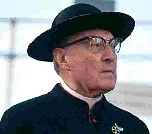
(30) 30. CAGGIANO, Antonio
(1889-1979)
Birth. January 30, 1889, Coronda, diocese of Santa Fe, Argentina. Son of Teodoro Dei Cas and Francisca Zubieta. His father came from San Pietro, Valdisotto, Sondrio, Italy; and his mother from Larrau, Pyrénées-Atlantiques, France. He was the seventh of eleven children.
Education. Studied at the Seminary of Santa Fe.
Priesthood. Ordained, March 23, 1912, Santa Fe. Pastoral ministry in Santa Fe, 1912-1913. Faculty member of the Seminary of Santa Fe, 1913-1931. Pastoral ministry in the Argentinian Catholic Action, 1913-1931; national chaplain, 1931-1933. Vicar general of the Military Ordinary, 1933-1934.
Episcopate. Elected bishop of Rosario, September 13, 1934. Consecrated, March 17, 1935, Rosario, by Filippo Cortesi, titular archbishop of Sirace, nuncio to Argentina, assisted by Nicolás Fasolino, archbishop of Santa Fe, and by Fortunado Devoto, titular bishop of Attea, auxiliary of Buenos Aires. His episcopal motto was Impendam et super impendar.
Cardinalate. Created cardinal priest in the consistory of February 18, 1946; received the red hat and the title of S. Lorenzo in Panisperna, February 22, 1946. Papal legate to the National Marian Congress, Catamarca, Argentina, April 24, 1954. Papal legate to the Congress of Catholic Education, La Paz, Bolivia, September 8, 1948. Attended the First General Conference of Latin American Episcopate, Rio de Janeiro, Brazil, July 25 to August 4, 1955. Persecuted by the Peronist regime, 1955. Papal legate to the Bolivarian Eucharistic Congress, Caracas, Venezuela, November 10, 1956. Participated in the conclave of 1958, which elected Pope John XXIII. Promoted to the primatial metropolitan see of Buenos Aires, August 15, 1959. Ordinary of the Armed Forces, December 14, 1959. Attended the Second Vatican Council, 1962-1965; member of the Board of Presidency, 1962-1965. Participated in the conclave of 1963, which elected Pope Paul VI. Lost his right to participate in the conclave by being older than eighty years, January 1, 1971. Resigned the pastoral government of the archdiocese of Buenos Aires, April 22, 1975. Cardinal protopriest, December 17, 1978.
Death. October 23, 1979, in Buenos Aires. Buried in the chapel of Sagrado Corazón y Santa Margarita María de Alcoque in the metropolitan cathedral of Buenos Aires (1). At his death, he was the oldest member of the Sacred College of Cardinals.
Webgraphy. Photographs and arms, Araldica Vaticana.
(1) This is the inscription on his vault, kindly provided by Mr. Eman Bonnici, from Malta:
CARDENAL ANTONIO CAGGIANO PRIMER OBISPO DE ROSARIO 1935-1959 ARZOBISPO DE BUENOS AIRES 1959-1975 30-I-1889 - 23.X.1979 RECORDADME ANTE EL SEÑOR JESUS
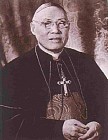
(31) 31. TIEN KEN-SIN, S.V.D., Thomas
(1890-1967)
Birth. October 24, 1890, Chantsiu (Yangku), apostolic vicariate of Yangku, China. Son of Kilian Tien Ken-sin, a non-Christian teacher of literature, and Maria Yang. His father joined the staff of Puoli Seminary in 1897, and was baptized before his death two years later. The seminary took care of the orphaned boy, who was still a pagan, and in 1901, at the age of 11, he too was baptized, taking the name Thomas. His last name is also listed as Tien ken-Sin Tung-Lai; as Tien Ken-hsin; as Tian Gengxin; and as Tienchensing.
Education. From 1904, he studied at the Seminary of Yen-chow-fu; he contracted tuberculosis and was told that he had to leave the seminary; but, following the advice of a priest friend who told him to stay until the rector would push him out, he resisted all opposition and was finally ordained.
Priesthood. Ordained, June 9, 1918, Yen-chow-fu, by Augustine Hemminghaus, S.V.D, titular bishop of Ipepa, vicar apostolic of Yen-chow-fu. For three years he taught in mission schools. Then he was transferred to Shantung Province to exercise his pastoral ministry. In that area, brigands and warlords were making life difficult, but the young Father Tien demonstrated that he was fearless in face of grave danger and stayed in that province. Joined the Society of Divine Word, March 8, 1929, at the Novitiate of Steye, Holland; he took his first vows on February 2, 1931; and the final vows on March 7, 1935. Prefect apostolic of Yangku, February 2, 1934.
Episcopate. Elected titular bishop of Ruspe and appointed apostolic vicar of Yangku (Yanggu), July 11, 1939. Consecrated, October 29, 1939, Rome, by Pope Pius XII, assisted by Celso Costantini, titular archbishop of Teodosiopoli di Arcadia, secretary of the S.C. for the Propagation of the Faith, and by Heinrich Streicher, M.Afr., titular archbishop of Brisi. His episcopal motto was Adveniat regnunm tuum. Apostolic vicar of Tsingtao (Qingdao), November 10, 1942.
Cardinalate. Created cardinal priest in the consistory of February 18, 1946; received the red hat and the title of S. Maria in Via, February 22, 1946. Promoted to metropolitan see of Peiping (Peking, Beijing), April 11, 1946. In 1948, because of declining health and of the approach of the Communist armies, he left Peking, and went to Shanghai first, and then to Hong Kong. He finally went to reside at the mother-house of the Divine Word Fathers in Illinois, United States of America; from there, he continued to work tirelessly, in spite of his bad health, for the Church in China. In 1958, he went to Europe to raise funds for a seminary in Taiwan; while there, he was involved in a serious traffic accident. Soon after, Pope Pius XII died; the doctors advised against the trip to Rome for the conclave, but he went. Participated in the conclave of 1958, which elected Pope John XXIII. Apostolic administrator of Taipei, Formosa, December 16, 1959 until February 15, 1966. Attended the Second Vatican Council, 1962-1965. Participated in the conclave of 1963, which elected Pope Paul VI. For many months before his death, he was an invalid, confined to hospital and incapable of any form of active ministry. Suffering from paralysis of the stomach and digestive area on July 22, 1967, although he had lapsed into a coma, the use of an oxygen mask caused some improvement in his condition. Archbishop Giuseppe Caprio, titular archbishop of Apollonia, apostolic pro-nuncio to India, Archbishop Paul Yü Pin of Nanking, rector of the Fu Jen Catholic University, and other church dignitaries hurried to Chiayi to be near the dying cardinal. He was the first Chinese cardinal.
Death. Monday July 24, 1967, at 6:45 a.m., of pneumonia, at St. Martin de Porres Hospital, Chiayi, Taipei, Central Taiwan. Pope Paul VI sent a telegram of condolence to Archbishop Stanislaus Lo Kuang of Taipei. President Chiang Kai-shek and Madame Chiang also sent a telegram of condolence, as did Vice-President and Premier C. K. Yen. The solemn requiem Mass and funeral services were held in Chiayi on July 28; they were attended by the Catholic hierarchy, and by priests, religious and laymen from all over Free China. Buried in the metropolitan cathedral of Taipei; his remains were eventually transferred to the Cardinal Tien Memorial Chapel at the SVD mission station in Chiayi, south of Taiwan. A solemn requiem Mass was celebrated in the cathedral, Hong Kong, at 6 p.m. on the following Monday July 31. Another solemn requiem Mass was celebrated in Taipei on August 24. A hospital of which he oversaw its foundation in the Xindian area in Taipei City after raising funds in West Germany, was named after him upon its inauguration in October 1968, a year after his death.
Bibliography. Brender, Andreas ; Kierein-Kuenring, Mandred D. Catholic Hierarchy in China since 1307. Cluj-Napoca, 2012, pp. 185, 232, 63, 279 and 290; Code, Bernard. Dictionary of the American Hierarchy (1789-1964). New York : Joseph F. Wagner, 1964, p. 447; Fleckner, Johannes. Thomas Kardinal Tien. St. Augustin : Steyler Verlag, 1975. (Studia instituti missiologici societatis verbi divini ; Nr. 16; Variation: Studia Instituti Missiologici Societatis Verbi Divini ; Nr. 16).
Webgraphy. Photograph and biographical information, in Chinese and English, Hong Kong Catholic Diocesan Archive; photographs and arms, Arladica Vaticana.
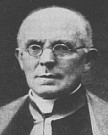
(32) 32. BRUNO, Giuseppe
(1875-1954)
Birth. June 30, 1875, Sezzadio, diocese of Acqui, Italy.
Education. Studied at the Seminary of Acqui; later, at the Pontifical Athenaeum "S. Tommaso d'Aquino", Rome, where he earned a doctorate in philosophy; then, at the Pontifical Athenaeum "S. Apollinare", Rome, obtaining doctorates in theology and utroque iure, both canon and civil law); finally, attended the Studium of the Sacred Roman Rota, becoming a curial lawyer; and Accademia di S. Cecilia, Rome, where he studied music.
Priesthood. Ordained, April 10, 1898, Acqui. Pastoral ministry in Acqui. Further studies in Rome. Secretary of the Roman Theological Academy, Rome. Director of Acta Sanctae Sedis, and of Acta Apostolicae Sedis, Rome. Professor of law at the Pontifical Athenaeum "S. Apollinare" for many years. Vice-auditor of the S.C. of the Council, 1905. Aiutante di studiio of the S.C. of the Council, 1908. Privy chamberlain of His Holiness, March 4, 1922. Domestic prelate of His Holiness, January 3, 1923. Secretary of the Pontifical Commission for the Authentic Interpretation of the Code of Canon Law, February 14, 1924. Under-secretary of the S.C. of the Council, December 8, 1926; secretary, July 1930-1946. Secretary of the Pontifical Commission for the Academy of Theology, and commissary of the Pontifical Institute of Christian Archeology, Rome, December 15, 1928. Secretary of the S.C. of Council, July 3, 1930. Protonotary apostolic, July 25, 1932.
Cardinalate. Created cardinal deacon in the consistory of February 18, 1946; received the red hat and the deaconry of S. Eustachio, February 22, 1946. His cardinalitial motto was Iustitia et pax. Prefect of the S.C. of Council, November 16, 1949 to March 20, 1954. Camerlengo of the Sacred College of Cardinal, January 12, 1953 until May 20, 1954. Prefect of the Supreme Tribunal of Apostolic Signature, and of the Pontifical Commission for Authentic Interpretation of the Code of Canon Law, March 20, 1954.
Death. Wednesday November 10, 1954 (1), at 5:30 p.m., of complications from liver cancer, in his residence at Lungotevere Vallanti, no. 10, Rome, after having received the holy sacraments and the papal blessing. The funeral took place on Saturday November 13, 1954 at the basilica of S. Maria sopra Minerva, Rome; Giuseppe dell'Olmo, bishop of Acqui, celebrated the Mass; fourteen cardinals were present; at the end of the ceremony, Cardinal Clemente Micara, vice-dean of the Sacred College of Cardinals, imparted the absolution nomine Summi Pontificis. His body was buried in Campo Verano cemetery, Rome.
Bibliography. Molari, Carlo. La Pontificia Università lateranense : profilo della sua storia, dei suoi maestri, e dei suoi discepoli. Roma : Libreria editrice della Pontificia Università lateranense, 1963, p. 219; L'Osservatore Romano [electronic resource]. Città del Vaticano : L'Osservatore Romano, XCIV, n. 263 (November 12, 1954), p. 2; XCIV, n. 264 (November 13, 1954), p. 2; and XCIV, n. 265 (November 14, 1954), p. 2: Del Re, Niccolò. "I cardinali prefetti della Sacra Congregazione del Concilio dalle origini ad oggi (1564-1964)." Apollinaris, XXXVII (1964), pp. 146-147.
(1) This is according to "Cardinali defunti." Annuario pontificio per l'anno 1955 (Città del Vaticano : Tipografia poliglotta vaticana, 1955), p. 82; Del Re, "I cardinali prefetti della Sacra Congregazione del Concilio dalle origini ad oggi (1564-1964)." Apollinaris, XXXVII (1964), p. 147; and L'Osservatore Romano, XCIV, n. 263, p. 2. Molari, Carlo. La Pontificia Università lateranense, p. 219, says that he died on November 11, 1954.
Webgraphy. Biographical entry, in Italian, Enciclopedia on line, Treccani; his arms, Araldica Vaticana.
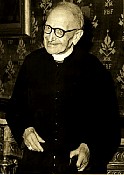
CARINCI, Alfonso
(1862-1963)
Birth. November 9, 1862, Rome. His father was a prominent archeologist. As an altar boy, young Alfonso attended the First Vatican Council (1869-1870), when he was 8. At nearly one hundred years of age, he participated as a council father in the first two sessions of the Second Vatican Council (1962-1965).
Priesthood. Ordained, December 19, 1885. Director general of the society Adoratio Quotidiana et Perpetua Sanctissimi Eucharistiae Sacramenti inter Sacerdotes Cleri Saecularis (Daily Perpetual Eucharistic Adoration for Diocesan Priests). Rector of Almo Collegio Capranica, Rome, from 1911 to 1930; during those years, Eugenio Pacelli, future Pope Pius XII, was a student at that collegio. Dean of the College of Protonotaries; as such, he was handed a brilliantly illuminated parchment manuscript, the papal bull of Pope Pius XII which proclaimed 1950 a Holy Year of pilgrimage to Rome.
Cardinalate. According to The New York Times, December 7, 1963, Pope Pius XII offered to promote Archbishop Carinci to the cardinalate in 1945, but the archbishop is reported to have declined on the grounds that he was too old. He declared that "at my age" the expense for the cardinal's robes would be "superfluous".
Episcopate. Elected titular archbishop of Seleucia in Isauria and appointed secretary of the S.C. of Rites, December 15, 1945. Consecrated, January 6, 1946, by Cardinal Carlo Salotti, assisted by Emilio Baroncelli, bishop of Veroli, and by Luigi Traglia, titular archbishop of Cesarea di Palestina, vice-gerent of Rome. In July 1959, he was diagnosed with recidive broncho, a pulmonary infection; he sought recovery at the Fatebenefratelli Hospital of Rome, where he made a speedy recovery; on September 24, 1959, Pope John XXIII paid him a personal, unexpected visit at the hospital. He resigned his post on January 5, 1960. He attended the first and second sessions of the Second Vatican Council (1962-1963). On November 8, 1962, the day before his one hundredth birthday, during the council, he rose and thanked the participants for their good wishes; he said he hoped each one of them would live as long as he had. The next day, his birthday, he said his 27,800th Mass, then went home to mark the day with a quiet celebration. He had a whipped cream birthday cake with two candles, a big one for his first century, a little one for the first year of his second.
Death. December 5, 1963, of heart ailment, at the Fatebenefratelli Hospital, where he had celebrated his 101st birthday a month before; on the previous November 17, he had undergone surgery. Originally buried in Campo Verano cemetery, Rome, his remains were transferred at a later date to the church of Santa Maria del Suffragio in via Giulia, Rome and reburied in the chapel of Santa Maria Consolatrice degli Afflitti, inside the same vault in which years later was also buried future Blessed Monsignor Luigi Novarese in 1984. His marker reads:
ALFONSO CARINCI ARCIVESCOVO TITOLARE DI SELEUCIA 9 - XI - 1862 ROMA 6 - XII - 1963 LUMINOSO ESEMPIO DEL CLERO ROMANO (PAOLO VI)
Webgraphy.Biography, in Italian, Wikipedia; his photograph celebrating his 100th birthday, Alamy; his photograph, tomb and biography by Eman Bonnici, in English, Find a Grave.
©1998-2023 Salvador Miranda.